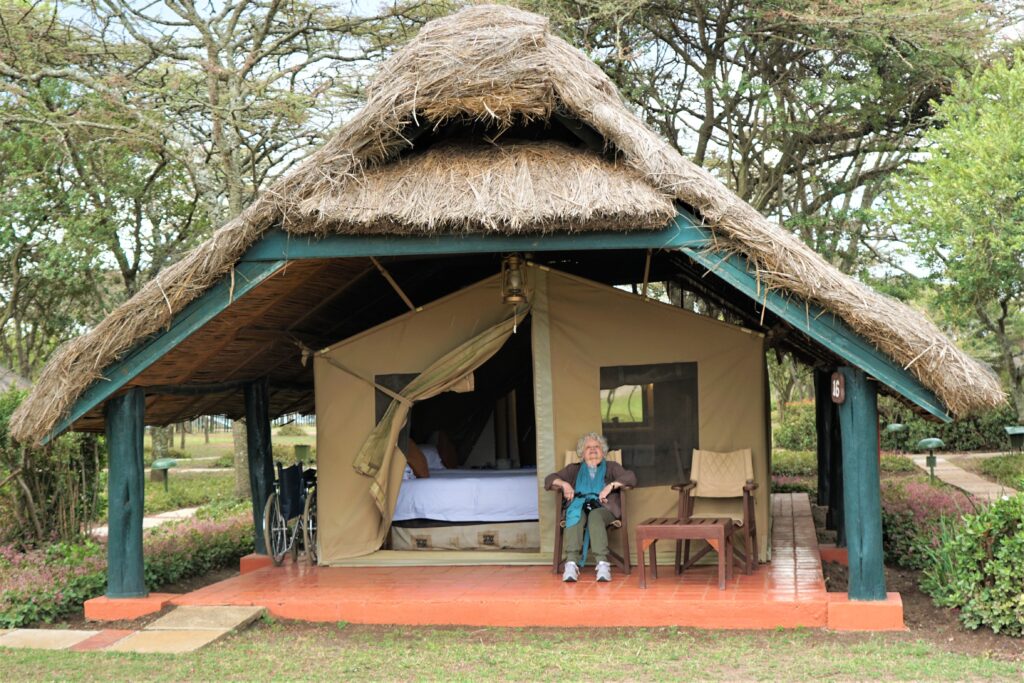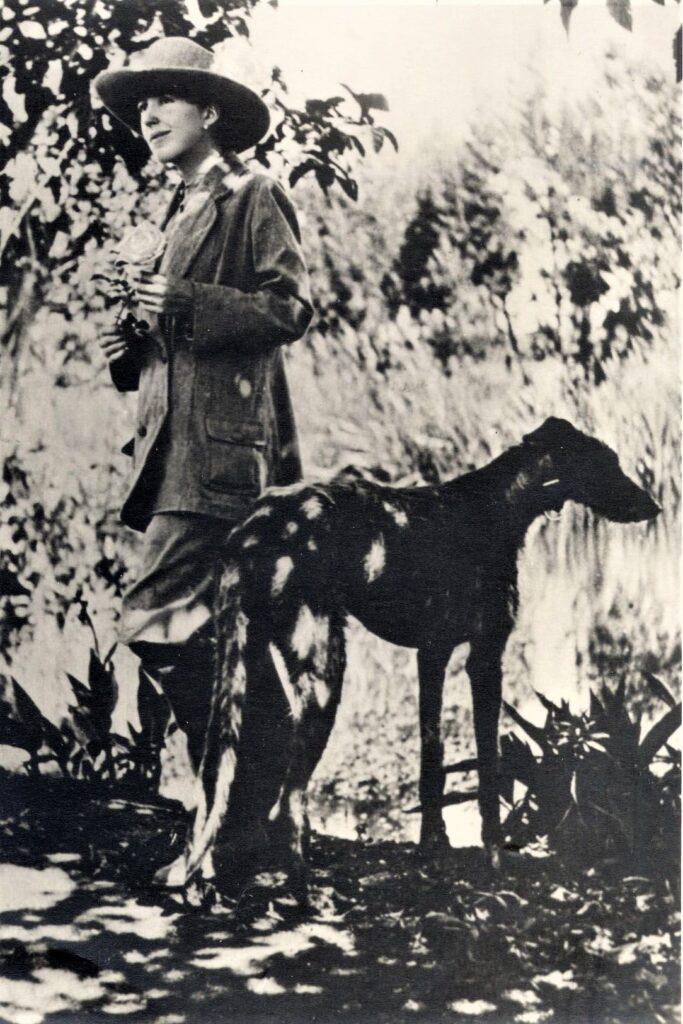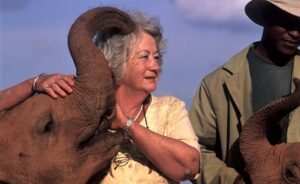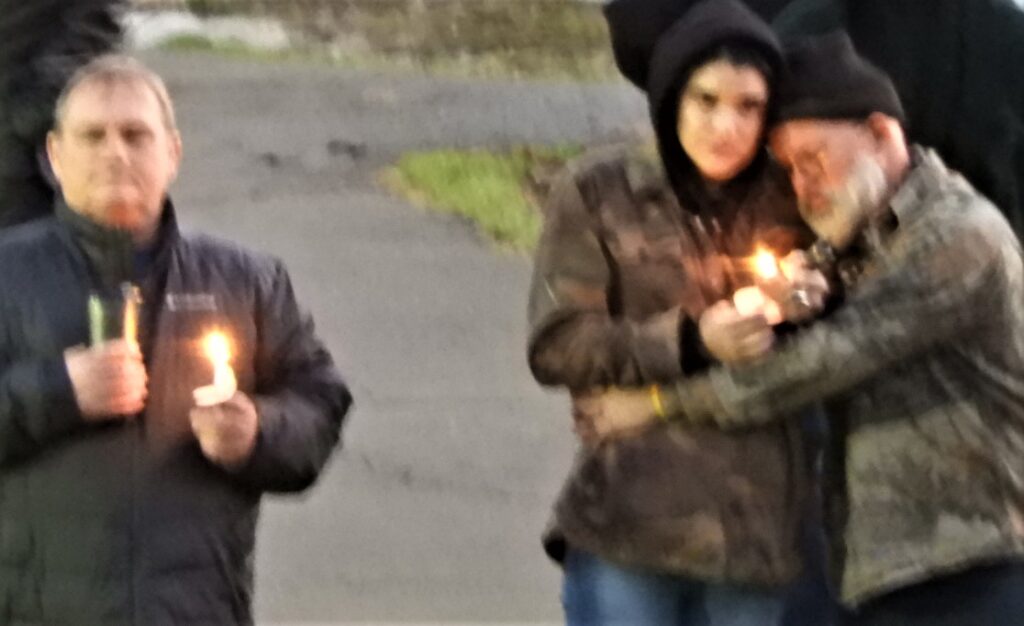‘2022’ Category
» posted on Monday, September 12th, 2022 by Linda Lou Burton
Hurry Up and Wait
Linda Lou Burton posting from Sweetwaters Serena Camp, Ol Pejeta Conservancy, Nanyuki, Kenya – Hurry up and wait! That’s what you do, when you’re on a trip, especially  when it’s planned by somebody else. Wait for instructions. Hurry to be on time. Then wait for everyone else to show up. Keep looking back to see what you forgot. Blink a lot. Meet the guide. Meet the gang. Check out. Where is our
when it’s planned by somebody else. Wait for instructions. Hurry to be on time. Then wait for everyone else to show up. Keep looking back to see what you forgot. Blink a lot. Meet the guide. Meet the gang. Check out. Where is our 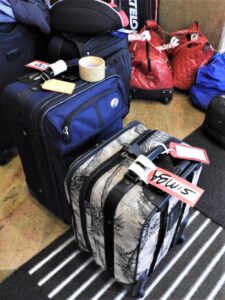 luggage? Which van do we get in? And that was just the beginning of our last day in Nairobi.
luggage? Which van do we get in? And that was just the beginning of our last day in Nairobi.
Our Monday morning wake-up call: 5:30 AM. Take turns in the bathroom; clothes laid out the night before, in order. Who could think, so early? Money belt with passport inside the first thing to put on, shoes the last. Who could eat so early? But we did. We had an organizational meeting at 7:00; notice given the night before that we were LEAVING TOWN by 8:00.
Of course we didn’t. In a room near the lobby we met Abdi, our Safari Guide. ABDI! Our Leader, our Teacher, our Troubleshooter, our Pit Boss for the next weeks. Our Expert-on-Africa. He went over the rules, the plans, the expectations. He introduced our drivers. DANIEL, our driver from yesterday, well yea, Rick and I were pleased about that. FRANK, a tall, humorous young man who stood up to say “I’m not Sinatra!” Then introductions around the circle: Otis and Venita (from Texas); Mike and Lois (from Texas); Judy (from Texas). Ed and Maureen broke the streak – they claimed Kentucky as home; Rick Washington; me Arkansas. I was the oldest in the 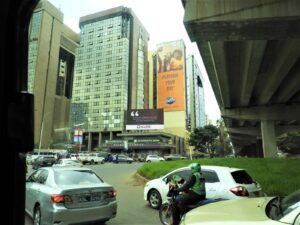
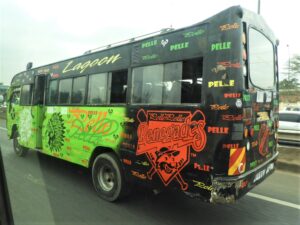 group. “Have Cane, Will Travel,” I said.
group. “Have Cane, Will Travel,” I said.
Out front, confusion. My bag was tagged SIMBA, to match the picture of the lion taped to the window of our 4×4. We were blurry, confused, scrambling for seats. And then we were gone! It was 8:49 as we headed out the guarded gate of the Nairobi Serena. Downtown we passed under the freeway, turned on A2 by the Co-operative Bank (is there an un-cooperative bank?). Morning traffic rush, cars headed in, matatus (those vividly decorated private buses) whizzing out, cattle marching along the edge. I’d studied the maps months earlier so I’d know what to expect once we left the city.
I knew it was 130 miles to Sweetwaters Serena, our first tent-camp. A 4-hour drive, according to Google. I had my list of towns we’d pass through, how fun, I thought, to see the countryside!
- RUIRU. Population 490,120. Altitude 5,135 feet. Once a coffee-growing area; now mostly housing.
- THIKA. Population 279,429. Altitude 5,351 feet. A major commercial hub. Ol Donya Sabuk National Park near.
- MURANGA. Population 110,000. Altitude 4,120 feet. Traders and farmers here; a busy matatu terminal.
- SAGANA. Population 13,000. Altitude 5,450 feet. Tourist attractions along the Sagana River.
- KARATINA. Population 6,852. Altitude 6,129 feet. Largest open-air market in Kenya. Residents 90% Kikuyu.
- NANYUKI. Population 49,233. Altitude 6,250 feet. On the Equator, the base for people climbing Mt Kenya.
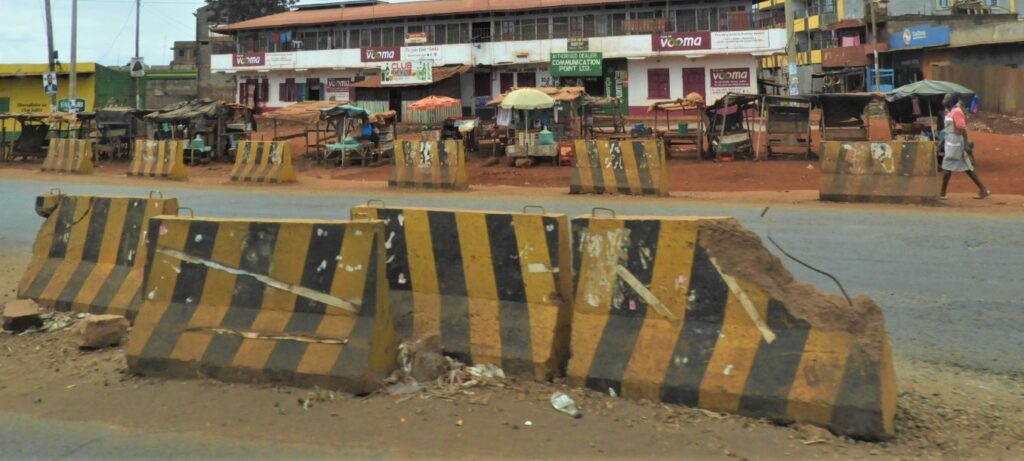 Now here is where expectations met reality. A2 was bumpy, dusty, rigged with speed bumps at every commercial spot. “The Sleeping Police,” Daniel explained to us as he slowed. Again, and again, and again. I clung to the strap, I was third row back in the 4×4 and my seat belt kept slipping. I banged my head against the window; tried to focus on the passing scene.
Now here is where expectations met reality. A2 was bumpy, dusty, rigged with speed bumps at every commercial spot. “The Sleeping Police,” Daniel explained to us as he slowed. Again, and again, and again. I clung to the strap, I was third row back in the 4×4 and my seat belt kept slipping. I banged my head against the window; tried to focus on the passing scene.
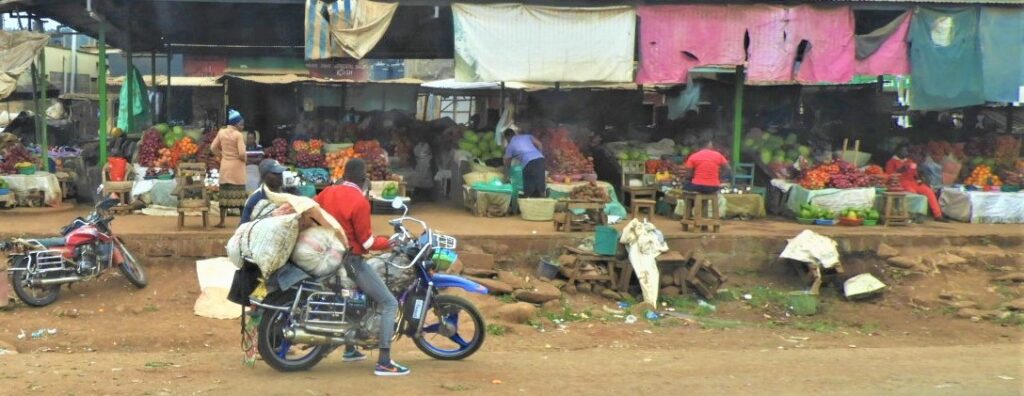 The markets were busy, swarming with people, motorbikes, bananas, tomatoes, melons, produce of every kind. There was commerce going on; action, color, noise. Inside our vehicle, Abdi called our attention to points of interest — the Teachers College, the river, the papaya trees. “Wow!” was repeated, endlessly, by one of our gang. “Wow!” to the Teachers College. “Wow!” to the river. “Wow!” to the papaya trees. I got a headache.
The markets were busy, swarming with people, motorbikes, bananas, tomatoes, melons, produce of every kind. There was commerce going on; action, color, noise. Inside our vehicle, Abdi called our attention to points of interest — the Teachers College, the river, the papaya trees. “Wow!” was repeated, endlessly, by one of our gang. “Wow!” to the Teachers College. “Wow!” to the river. “Wow!” to the papaya trees. I got a headache.
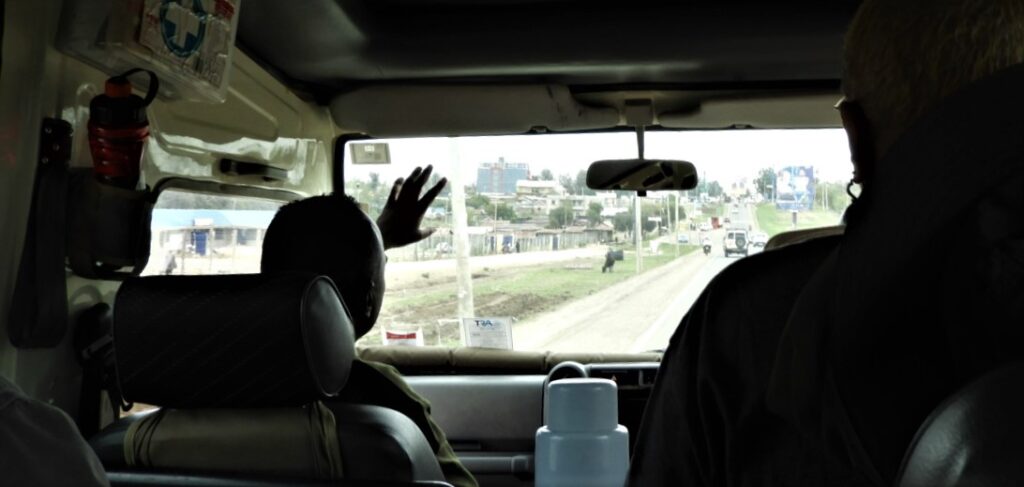 A short stop at a souvenir shop. I didn’t want to shop. Daniel brought me a chair and a coke while the others bartered for elephants carved out of wood and paintings that would roll up for shipping (we can ship anything direct to your house). Finally, (finally!) back on the road; the scene more rural now; simple roadside stands and fertile farmland.
A short stop at a souvenir shop. I didn’t want to shop. Daniel brought me a chair and a coke while the others bartered for elephants carved out of wood and paintings that would roll up for shipping (we can ship anything direct to your house). Finally, (finally!) back on the road; the scene more rural now; simple roadside stands and fertile farmland.
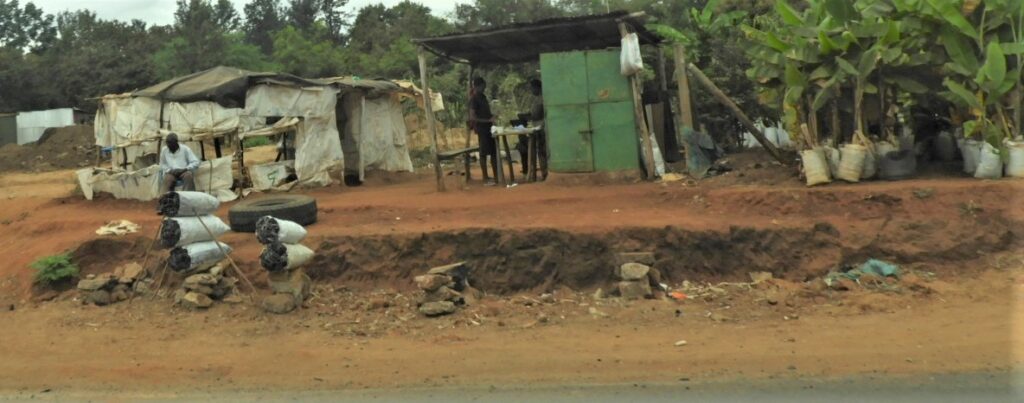 We passed small family plots with tin-roofed barns; we passed huge open fields stretching for miles towards Mt Kenya in the east. We passed Maisha Flour Mills, with its giant grain silos. I asked Abdi about the main products that come out of Kenya; the answer surprised me — concrete, flowers, wheat.
We passed small family plots with tin-roofed barns; we passed huge open fields stretching for miles towards Mt Kenya in the east. We passed Maisha Flour Mills, with its giant grain silos. I asked Abdi about the main products that come out of Kenya; the answer surprised me — concrete, flowers, wheat.
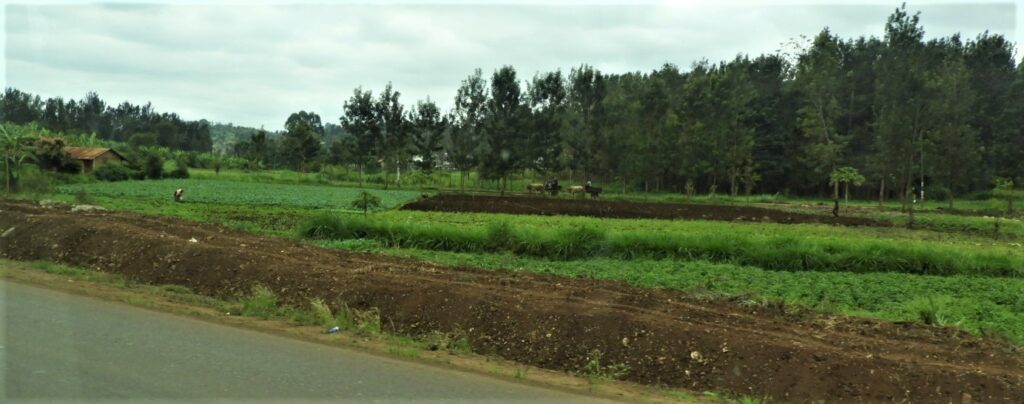 And then we were in Nanyuki; a big yellow sign splashed out the news: You Are At The Equator! We begged to stop; but it was almost 1:30 then, and lunch was waiting at the camp. “We’ll get pictures on the Equator tomorrow,” Abdi promised.
And then we were in Nanyuki; a big yellow sign splashed out the news: You Are At The Equator! We begged to stop; but it was almost 1:30 then, and lunch was waiting at the camp. “We’ll get pictures on the Equator tomorrow,” Abdi promised.
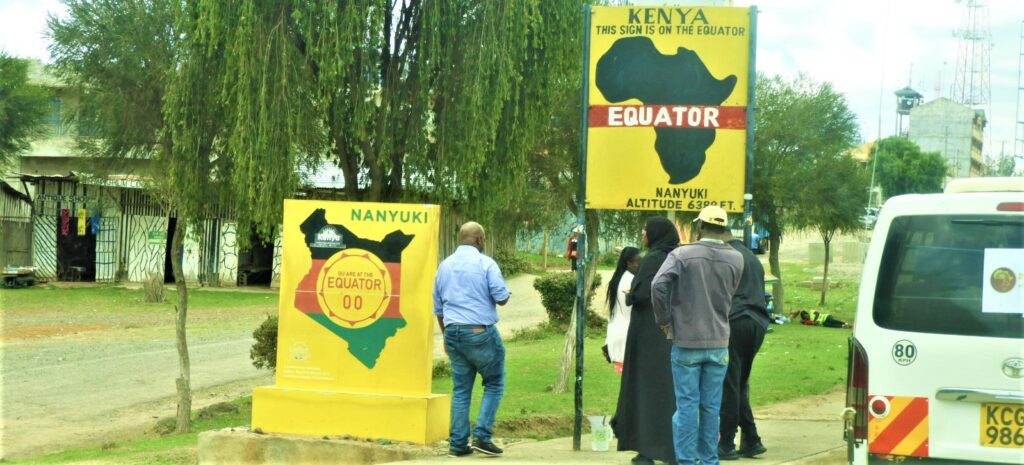 Daniel made a left onto Nanyuki-Marura Road. It was lined with tiny shops; a hardware store (Sand Blast & Ndarugo?); corrugated housing in a row, chickens wandering out front.
Daniel made a left onto Nanyuki-Marura Road. It was lined with tiny shops; a hardware store (Sand Blast & Ndarugo?); corrugated housing in a row, chickens wandering out front.
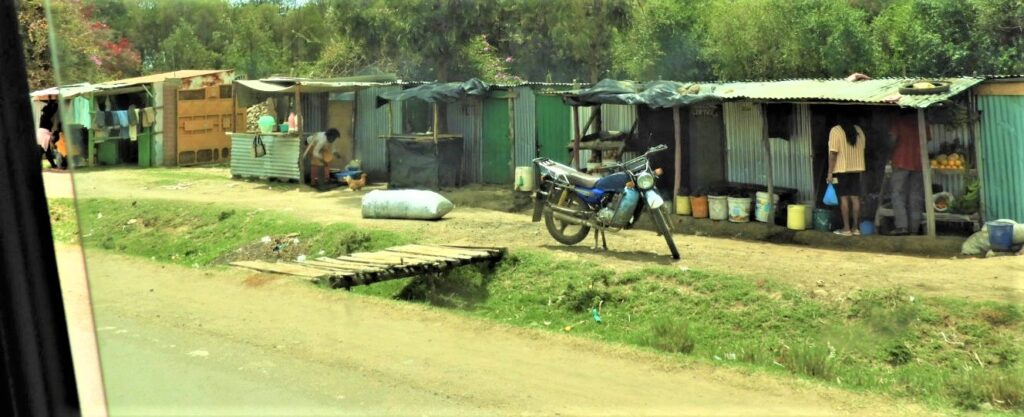 It was 1:49 when we reached Ol Pejeta Conservancy, where our tented camp was located. You’d better keep reading my posts, because this place is going to knock your socks off.
It was 1:49 when we reached Ol Pejeta Conservancy, where our tented camp was located. You’d better keep reading my posts, because this place is going to knock your socks off.
Some things are absolutely worth the wait.
» posted on Sunday, September 11th, 2022 by Linda Lou Burton
Benjamin and the Green Chair
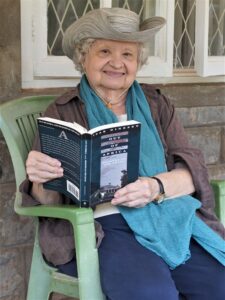 Linda Lou Burton posting from Nairobi, Kenya – I saw him bringing a chair as I approached the house. By the time I was there, he’d made a perfect spot for me. At last, I was seated on Karen Blixen’s verandah! Here’s me, holding the book Karen Blixen wrote; which was the inspiration that brought me here to Nairobi. I wanted to see what Karen saw. I wanted to see Africa. Now, here I was, looking out over the wide lawn, seated in a green plastic chair, all mixed up with emotions. “The past is never past,” it’s been said, and by golly, it’s true. The past is only how we remember it, and even that changes over time. When Karen wrote Out of Africa she was already back in Denmark, recalling moments that were precious to her; or heart-wrenchingly sad. Chapter titles reveal her swings in thought: The Ngong Farm. A Native Child. A Gazelle. Riding in the Reserve. The Shooting Accident. Big Dances. A Kikuyu Chief. Somali Women. Old Knudsen. Visits of Friends.
Linda Lou Burton posting from Nairobi, Kenya – I saw him bringing a chair as I approached the house. By the time I was there, he’d made a perfect spot for me. At last, I was seated on Karen Blixen’s verandah! Here’s me, holding the book Karen Blixen wrote; which was the inspiration that brought me here to Nairobi. I wanted to see what Karen saw. I wanted to see Africa. Now, here I was, looking out over the wide lawn, seated in a green plastic chair, all mixed up with emotions. “The past is never past,” it’s been said, and by golly, it’s true. The past is only how we remember it, and even that changes over time. When Karen wrote Out of Africa she was already back in Denmark, recalling moments that were precious to her; or heart-wrenchingly sad. Chapter titles reveal her swings in thought: The Ngong Farm. A Native Child. A Gazelle. Riding in the Reserve. The Shooting Accident. Big Dances. A Kikuyu Chief. Somali Women. Old Knudsen. Visits of Friends.
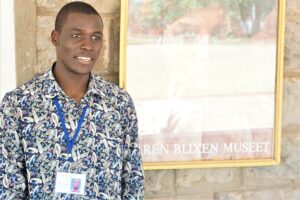 I’d come to see what I could see TODAY, that linked to Karen’s memories, and Benjamin was geared to tell. Benjamin was a handsome young man, a college student being funded by his work at the Museum. He knew his stuff; I’ve been studying Karen Blixen’s story for a long time, yet he told things I’d never heard before as he pointed to various posters displayed on the porch. Then it was time to go inside.
I’d come to see what I could see TODAY, that linked to Karen’s memories, and Benjamin was geared to tell. Benjamin was a handsome young man, a college student being funded by his work at the Museum. He knew his stuff; I’ve been studying Karen Blixen’s story for a long time, yet he told things I’d never heard before as he pointed to various posters displayed on the porch. Then it was time to go inside.
House Museums are generally stingy with what they allow visitors to do; and this was no exception. “No pictures,” Benjamin said, “but I’m bringing this chair inside so you can comfortably sit and hear what I say.” He led the way, green chair in hand, as we started out in the drawing room. My visions of the house (as I read the book) were completely dominated by the images in the 1985 Streep/Redford movie, and Benjamin assured us they were “basically” correct. Kumante Gatura, a Kikuyu who entered Karen’s life as a small boy and worked in the house until she left, was alive and on set during the movie-making, and gave his advice as to the correctness of what Sydney Pollack was trying to do.
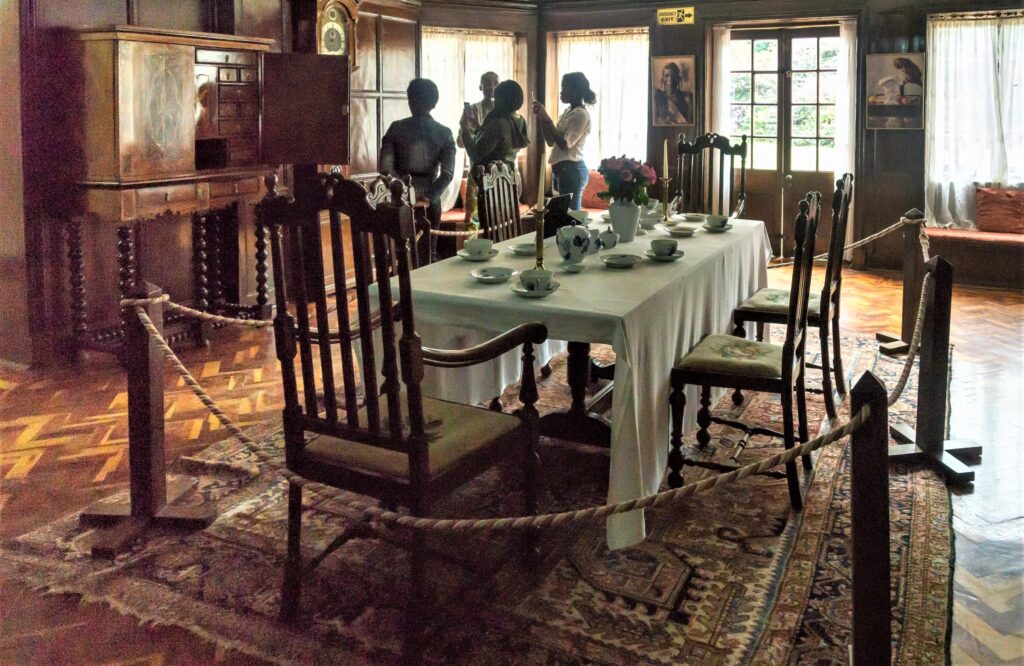 Benjamin moved my green chair from room to room, where I sat (and Rick stood) as he pointed out details – the dining table where Prince Edward sat during his 1928 visit; the desk where Karen sat to manage farm business, the cuckoo clock the children sneaked in to watch, the lion-skin rug. He had a story to tell about each, and he told each one with vigor, putting us there, in the moment. I wish I could show you what I saw, but I obeyed the rules. Which means, of course, any “inside photos” are lifted off a google search.
Benjamin moved my green chair from room to room, where I sat (and Rick stood) as he pointed out details – the dining table where Prince Edward sat during his 1928 visit; the desk where Karen sat to manage farm business, the cuckoo clock the children sneaked in to watch, the lion-skin rug. He had a story to tell about each, and he told each one with vigor, putting us there, in the moment. I wish I could show you what I saw, but I obeyed the rules. Which means, of course, any “inside photos” are lifted off a google search.
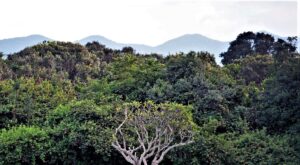 And then we were back outside, walking the grounds. Benjamin showed us how coffee beans grow on a tree (yes, one or two trees were left near the house). He pointed to the hills visible beyond the trees. “Those are the Ngong Hills Karen wrote about,” he said, “and that’s where Denys is buried. Ngong is a Swahili word for knuckles,” Benjamin
And then we were back outside, walking the grounds. Benjamin showed us how coffee beans grow on a tree (yes, one or two trees were left near the house). He pointed to the hills visible beyond the trees. “Those are the Ngong Hills Karen wrote about,” he said, “and that’s where Denys is buried. Ngong is a Swahili word for knuckles,” Benjamin 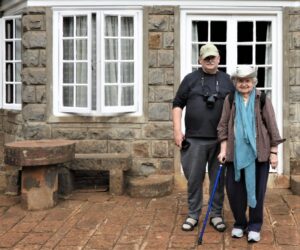
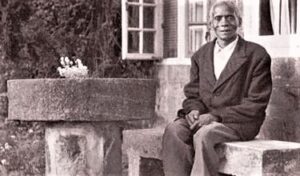 explained, holding up his folded hand to show the knuckles matching the hills in the distance. The large stone terrace at the back of the house is where Karen held “clinic” every morning at 9, Benjamin pointed out, dispensing first aid as needed to the natives who worked on her farm. Kumante helped with this every day. Rick and I posed for a picture between the two large millstone tables where they sat. I found a picture (online) of Kumante as an old man, sitting back there. I’m guessing it was when he came to assist in the movie-making.
explained, holding up his folded hand to show the knuckles matching the hills in the distance. The large stone terrace at the back of the house is where Karen held “clinic” every morning at 9, Benjamin pointed out, dispensing first aid as needed to the natives who worked on her farm. Kumante helped with this every day. Rick and I posed for a picture between the two large millstone tables where they sat. I found a picture (online) of Kumante as an old man, sitting back there. I’m guessing it was when he came to assist in the movie-making.
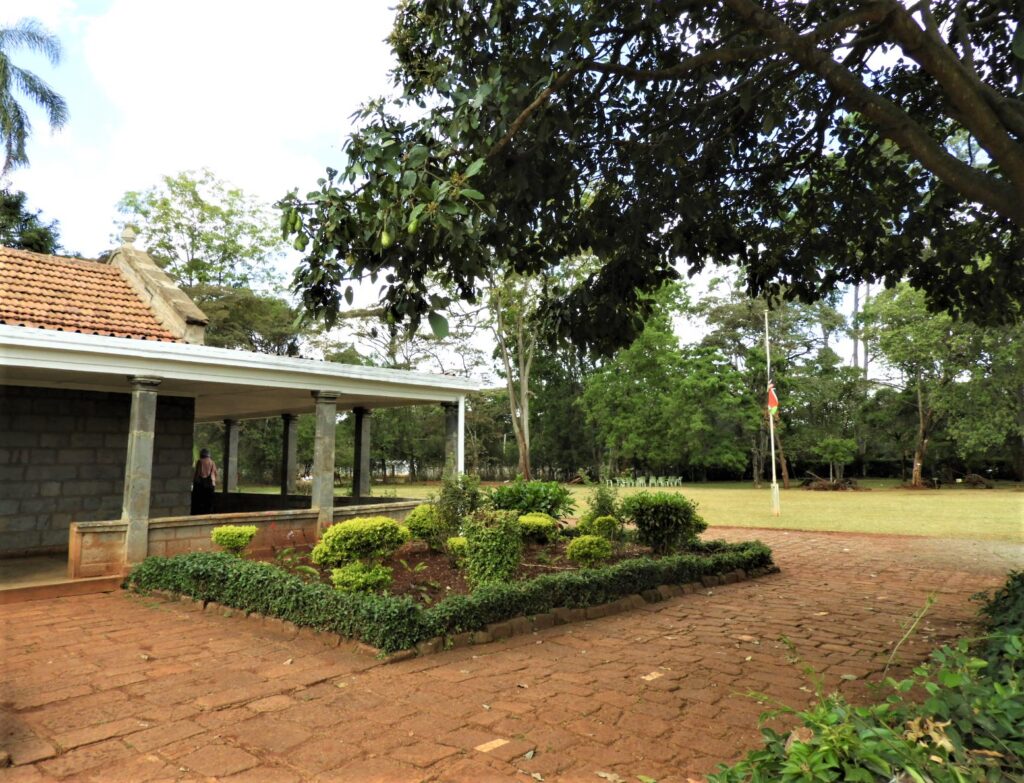 We completed our walk around the house, imagining the crowds gathered there daily, the workers, the children playing, the goats grazing. Here is where the big natives dances (ngomas) were held, with as many as a thousand Maasai coming to celebrate. Here is where Karen sat with Denys, listening to Mozart on the victrola he brought her. Here is where Karen’s belongings were sold when she lost the farm, and here is the last thing Karen saw, that day in 1931 when she had to leave Africa forever.
We completed our walk around the house, imagining the crowds gathered there daily, the workers, the children playing, the goats grazing. Here is where the big natives dances (ngomas) were held, with as many as a thousand Maasai coming to celebrate. Here is where Karen sat with Denys, listening to Mozart on the victrola he brought her. Here is where Karen’s belongings were sold when she lost the farm, and here is the last thing Karen saw, that day in 1931 when she had to leave Africa forever.
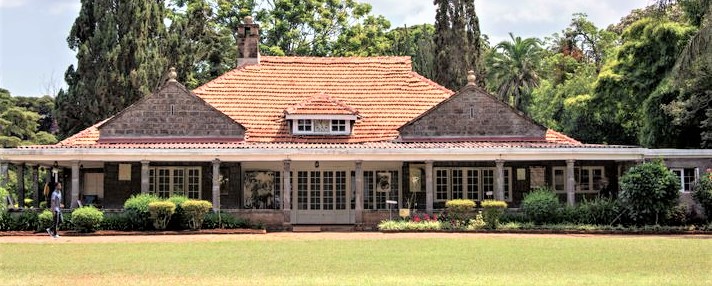 Our tour of the Karen Blixen Museum was over. I complimented Benjamin for the excellent presentation he made, thanked him for for the kindness of the green chair, wished him well. Rick waved to Daniel, and Blethwell, who were waiting with our vehicle just down the drive. We were quiet on the ride through the Karen suburb back to our hotel on Kenyatta Avenue, just thinking, I guess.
Our tour of the Karen Blixen Museum was over. I complimented Benjamin for the excellent presentation he made, thanked him for for the kindness of the green chair, wished him well. Rick waved to Daniel, and Blethwell, who were waiting with our vehicle just down the drive. We were quiet on the ride through the Karen suburb back to our hotel on Kenyatta Avenue, just thinking, I guess.
Karen Blixen Museum, Karen Road, Nairobi https://www.kenyamuseumsociety.org/karen-blixen-museum/
Residence in Kenya 1914-1931
Out of Africa published 1937
» posted on Sunday, September 11th, 2022 by Linda Lou Burton
Karen Says
Linda Lou Burton posting from Nairobi, Kenya – “Remember me?” The Elephant Feeding was over now; the crowd filing out. Blethwell was on my left, Rick on my right, which is where 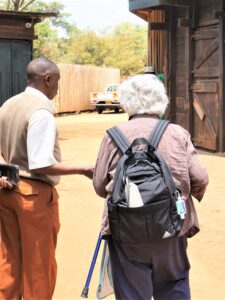 the voice came from. We paused, and there was Douglas! Douglas, who brought us from the airport Friday night. Rick stepped over, grabbed his hand. In all this crowd, here was a friend, remembering us. We stopped to chat, delighted to see a familiar face. Douglas had brought a group for the Elephant Feeding, he explained; he and Blethwell worked together, Globus representatives. We headed on, past the stables towards our vehicle; Daniel had pulled as close to the gate as possible. “Pole, pole,” he said as he helped me up my ladder step. “Are you ready for lunch?” “The Karen Blixen Museum is MY priority today,” I replied. “When do we go THERE?” “It’s open all afternoon,” Blethwell-the-scheduler answered. “First you get to relax over a nice lunch.”
the voice came from. We paused, and there was Douglas! Douglas, who brought us from the airport Friday night. Rick stepped over, grabbed his hand. In all this crowd, here was a friend, remembering us. We stopped to chat, delighted to see a familiar face. Douglas had brought a group for the Elephant Feeding, he explained; he and Blethwell worked together, Globus representatives. We headed on, past the stables towards our vehicle; Daniel had pulled as close to the gate as possible. “Pole, pole,” he said as he helped me up my ladder step. “Are you ready for lunch?” “The Karen Blixen Museum is MY priority today,” I replied. “When do we go THERE?” “It’s open all afternoon,” Blethwell-the-scheduler answered. “First you get to relax over a nice lunch.”
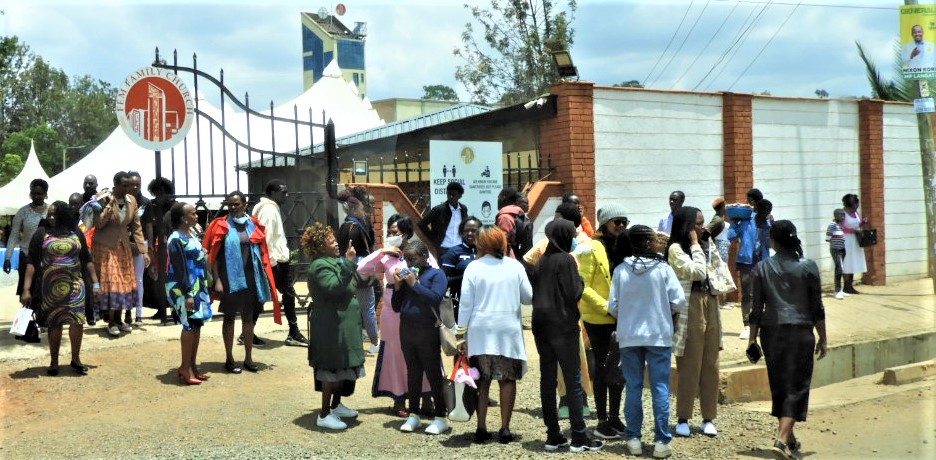 Daniel made a left past Galleria Mall, easing onto Langata Road. It was Sunday-after-church time and crowds were spilling onto the streets. “Where are all the church people going to eat?” I inquired, thinking how fun it would be to go there, the way we did after-church lunch in the old days when the kids were little. “They’re going for Sunday chicken,” Daniel laughed,
Daniel made a left past Galleria Mall, easing onto Langata Road. It was Sunday-after-church time and crowds were spilling onto the streets. “Where are all the church people going to eat?” I inquired, thinking how fun it would be to go there, the way we did after-church lunch in the old days when the kids were little. “They’re going for Sunday chicken,” Daniel laughed, 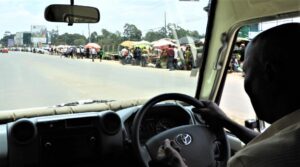 pointing to the stands lining the streets. We passed Karen Hospital, crossed over Karen Road, made a right at Ngong Road. Then he slowed, turned left into a walled area, gated, guarded. It began to sink into my consciousness: we left our hotel through a guarded gate; we entered the Giraffe Centre and the Elephant Orphanage through guarded gates, and now, were we to have our Sunday lunch in a guarded area? Apparently so.
pointing to the stands lining the streets. We passed Karen Hospital, crossed over Karen Road, made a right at Ngong Road. Then he slowed, turned left into a walled area, gated, guarded. It began to sink into my consciousness: we left our hotel through a guarded gate; we entered the Giraffe Centre and the Elephant Orphanage through guarded gates, and now, were we to have our Sunday lunch in a guarded area? Apparently so.
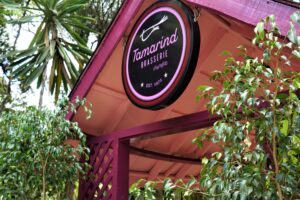
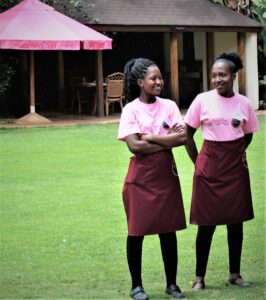
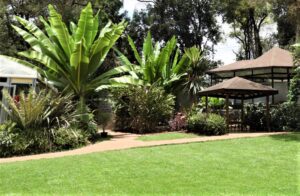 Tamarind Brasserie was a secluded, palm-surrounded haven of privacy, with individual covered patios around the perimeter of the grounds. Staff in pink uniforms sang greetings as we entered; I was escorted to my chair. “I’ll bring your food,” a beautiful young server said to me, “just tell me what you’d like.” Rick headed for the buffet with her; soon she returned with a perfectly arrayed plate of vegetables and rice for me; just what I’d requested. I thanked her, and commented on the peacefulness of the area. She smiled. “My name is Amani,” she said. “It means ‘peace’ in Swahili.”
Tamarind Brasserie was a secluded, palm-surrounded haven of privacy, with individual covered patios around the perimeter of the grounds. Staff in pink uniforms sang greetings as we entered; I was escorted to my chair. “I’ll bring your food,” a beautiful young server said to me, “just tell me what you’d like.” Rick headed for the buffet with her; soon she returned with a perfectly arrayed plate of vegetables and rice for me; just what I’d requested. I thanked her, and commented on the peacefulness of the area. She smiled. “My name is Amani,” she said. “It means ‘peace’ in Swahili.”
During the course of our lunch, as Amani continued to lavish attention on me, we exchanged details of our lives. “I share an apartment with my sister,” she said in answer to my question. “Whoever gets home first in the evening cooks for the other. We work long hours and have long drives so don’t have much spare time.” She asked about my life in the states; I drew an air-map of the US, pointing to my spot in the southern part of the country. By the time we got to dessert, Amani told me she planned to leave Kenya, explaining there were no jobs where she could use her education. “Where will you go?” I asked. “One of three places – Canada, Australia, or Germany,” she answered. “Pick Australia!” I laughed. “I’ve never met an Aussie I didn’t like, and Canada can get COLD in the winter.”
Blethwell appeared, checking to see if we were done; leading us across the grassy lawn, through the palm trees and flowers to the drive where Daniel waited with our vehicle. “Where did YOU guys eat lunch?” I inquired as we exited the gate. “A Sunday chicken place,” Daniel laughed. When we turned down Karen Road, I saw a sign advertising the Karen Blixen Museum ahead. We were in the Karen suburb, the white enclave of Nairobi.
I remembered a line from Karen Blixen’s Out of Africa book, written years after she left. Her 6,000-acre coffee plantation was a highlands area about ten miles from the 1913 town of Nairobi. Her dream for the natives – the Kikuyu and the Maasai that were such a part of her life – didn’t work out the way she’d hoped. Her plantation was bought by a company that dug up the coffee trees and divided the land into 20-acre plots. Her grief expressed in writing: “now the lands where my natives lived and worked are paved with tennis courts.”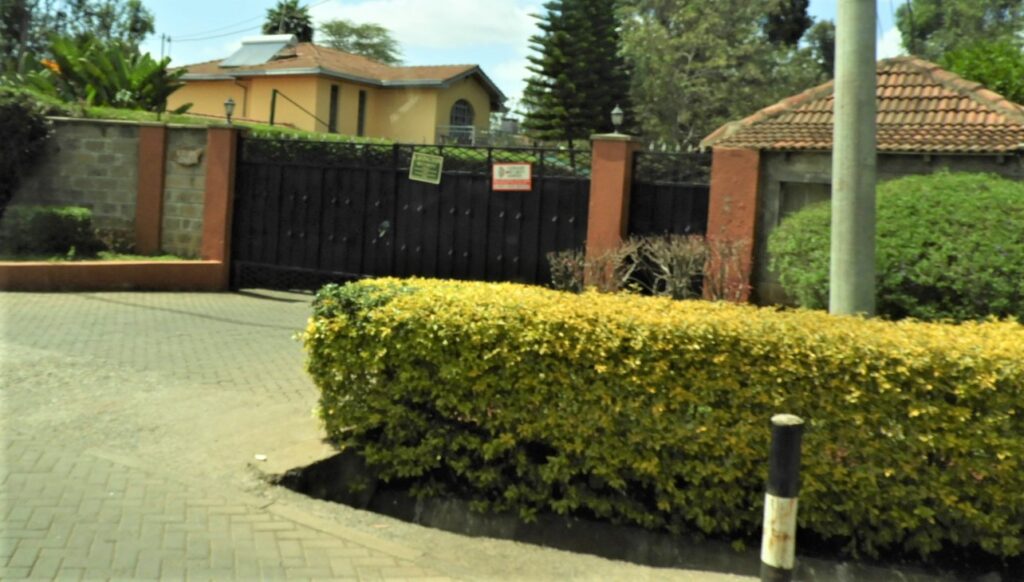
“That’s MY house,” Daniel joked, pointing to a rooftop visible behind a gated stone wall. As we continued down the road, I noted lean-tos on the outside of these barbed-wire topped mansion walls. I am puzzled now, really paying attention to my surroundings. “Karen” describes itself today as “a center for many upscale restaurants and hotels in the city, offering cuisines from around the world. It is a vibrant residential suburb characterized by big mansions, many trees, tranquil atmosphere, and plush gardens. 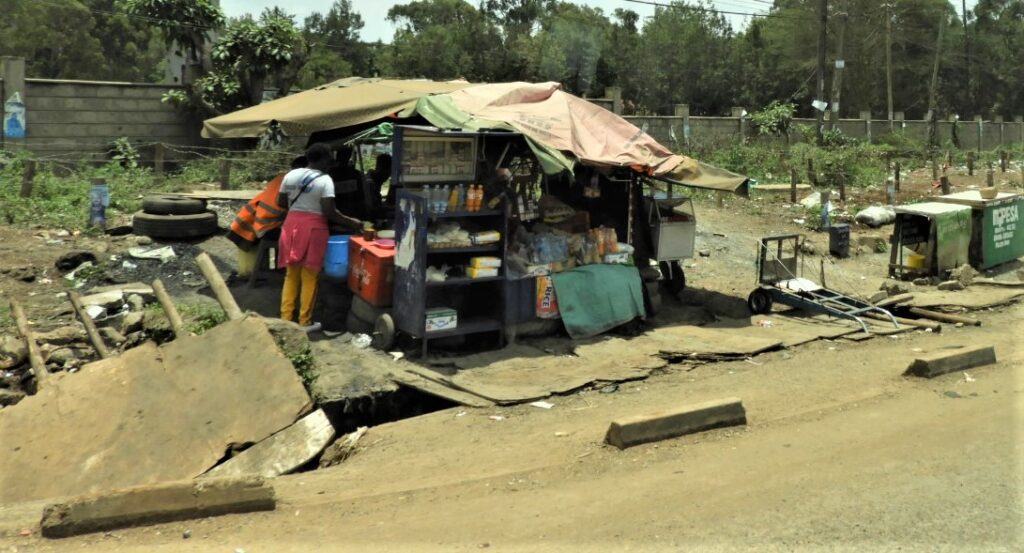
Depends, I guess, which side of the wall you’re on.
Next Stop: Karen Blixen Museum
» posted on Sunday, September 11th, 2022 by Linda Lou Burton
Horton’s Who in Action
Linda Lou Burton posting from Nairobi, Kenya – Blethwell began to nudge us down the Giraffe Centre’s ramp. “The Elephant Orphanage is only open one hour a day,” he explained. “We need to be there by 11.” Reluctantly we signed the Guest Book and headed for our vehicle, which Daniel had moved inside the gate, already savvy to my cane-assisted slow walk. ”Pole, pole,” he said, helping me climb the ladder-step he attached to our vehicle and offering me his arm for leverage. “Slowly, slowly.” “Pole” is pronounced “po-lay”, by the way.
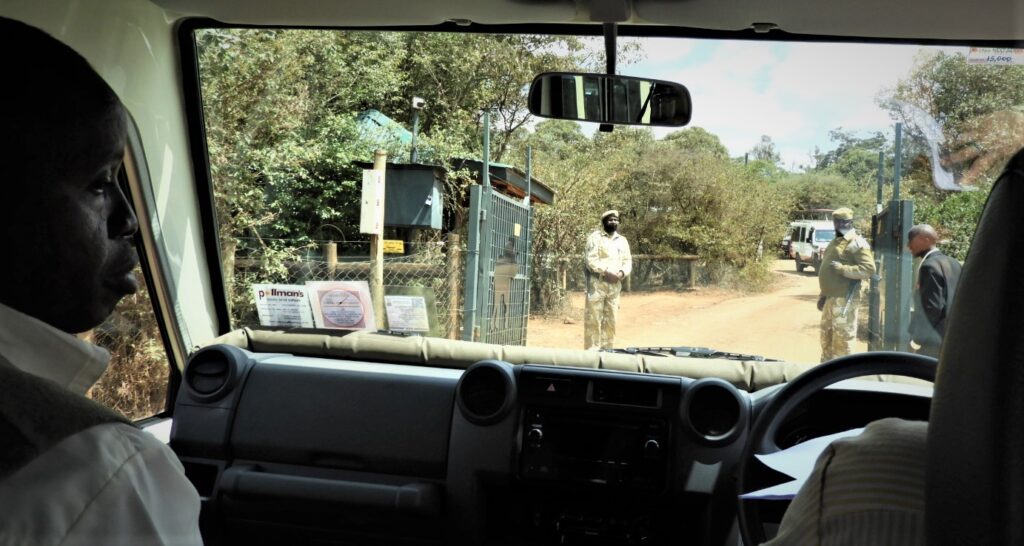 It was just four miles to Sheldrick Elephant Orphanage, which occupies an edge of Nairobi National Park. Traffic was heavy as we pulled into the drive; reservations had to be made far in advance for this special one-hour-a-day Elephant Feeding Time. Guards in uniforms, with guns, checked our ID at the gate. “We’ll have to stand back and observe,” Blethwell explained as we walked to the viewing area. “No interaction with the baby elephants is allowed, because the objective is to eventually re-integrate them into their native habitat.”
It was just four miles to Sheldrick Elephant Orphanage, which occupies an edge of Nairobi National Park. Traffic was heavy as we pulled into the drive; reservations had to be made far in advance for this special one-hour-a-day Elephant Feeding Time. Guards in uniforms, with guns, checked our ID at the gate. “We’ll have to stand back and observe,” Blethwell explained as we walked to the viewing area. “No interaction with the baby elephants is allowed, because the objective is to eventually re-integrate them into their native habitat.”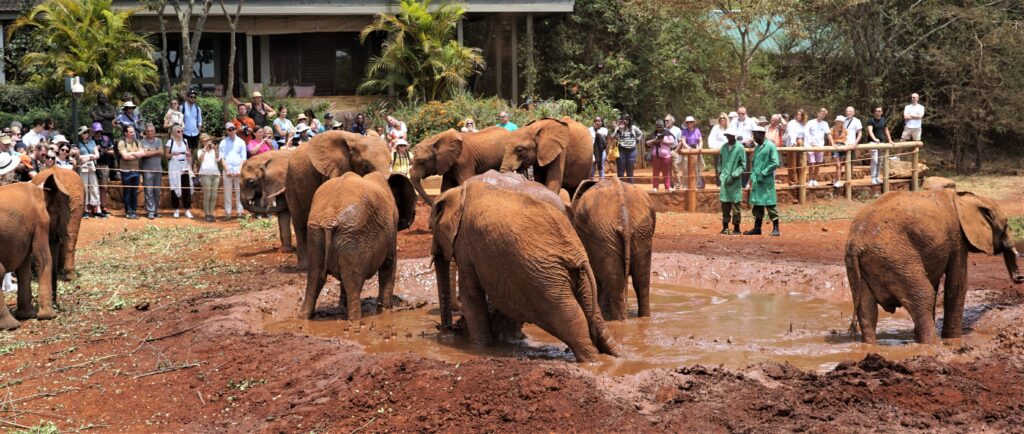
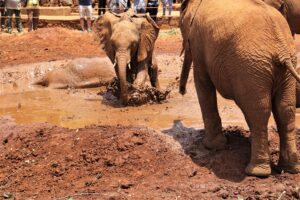
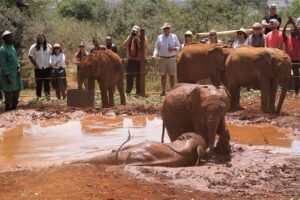
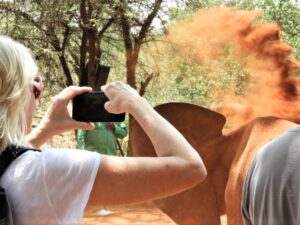 I found a bench on a raised terrace for watching, but Rick moved closer to the rope-enclosed ring, which was already surrounded by camera-toting viewers, already snapping pictures of the cutest scene since God made mud puddles. MUD PUDDLES! What kid can resist a MUD PUDDLE? A 2-year-old toddler elephant may weigh 1,900 pounds, but no amount of weight interferes with FUN. Splashing battles! Plopping flat right in the middle of the clay-red messy waters of the Baby Pond. Grabbing a trunkful of red clay dust and flinging it in the air to dry off.
I found a bench on a raised terrace for watching, but Rick moved closer to the rope-enclosed ring, which was already surrounded by camera-toting viewers, already snapping pictures of the cutest scene since God made mud puddles. MUD PUDDLES! What kid can resist a MUD PUDDLE? A 2-year-old toddler elephant may weigh 1,900 pounds, but no amount of weight interferes with FUN. Splashing battles! Plopping flat right in the middle of the clay-red messy waters of the Baby Pond. Grabbing a trunkful of red clay dust and flinging it in the air to dry off.
I thought cuteness had peaked off the scale, but no – a troop of “surrogate mothers” came marching out loaded with giant baby bottles and slurping time began. Our Master of Ceremonies explained that the formula is NOT elephant milk, but a mixture of coconut milk (closest to mother’s in fat content) and vitamins. As each baby slurped the treasured nectar, the name of each of the 27 babies was called out; each one’s age, where it was found and rescued, and the circumstances that created its “orphan” status. A mother who was killed by a poacher? A mother who died of starvation? A mother who was lost?
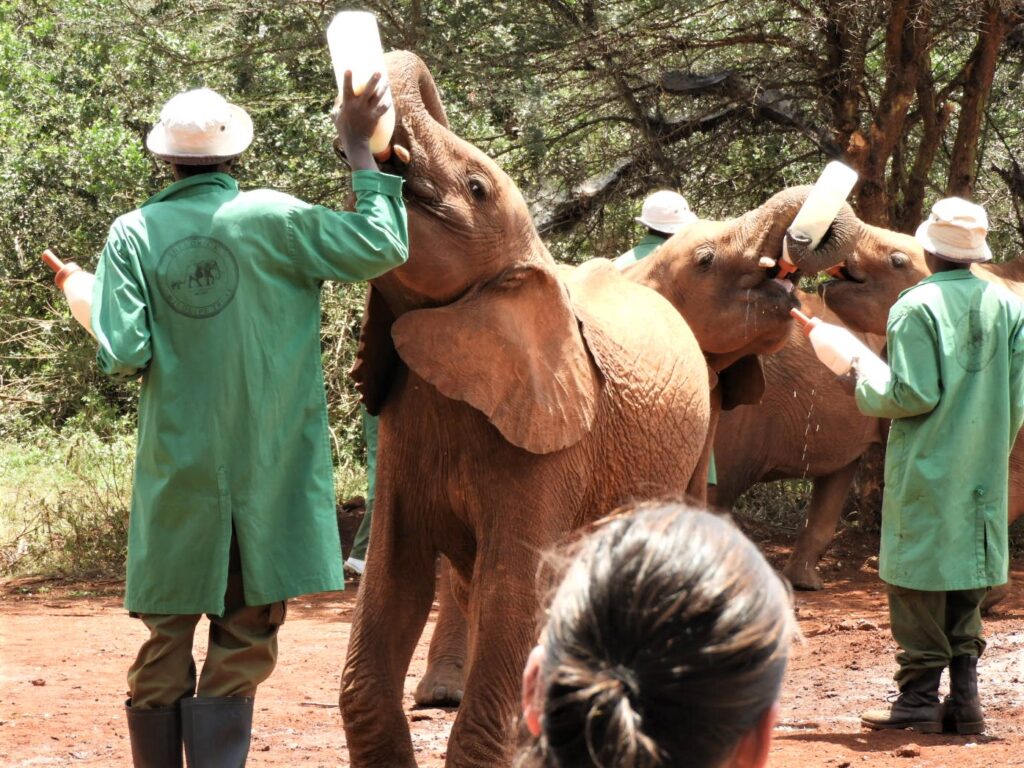 The tales of rescue and survival moved our attention back and forth. Heart wrenching cruelty. Loving 24-hour attention. Remember Horton Hears A Who from your Dr Seuss days? It made me think of that. The MC went on to tell us about each baby’s “keeper” – the green-coated boot-wearing guys who were handing off baby bottles as we watched. Here is the story of a baby’s evening:
The tales of rescue and survival moved our attention back and forth. Heart wrenching cruelty. Loving 24-hour attention. Remember Horton Hears A Who from your Dr Seuss days? It made me think of that. The MC went on to tell us about each baby’s “keeper” – the green-coated boot-wearing guys who were handing off baby bottles as we watched. Here is the story of a baby’s evening:
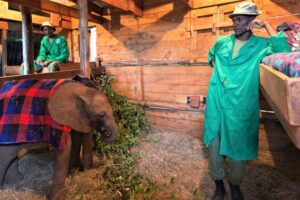 Each bedroom is stocked with a fresh layer of hay, a bundle of cut greens, and two bottles of warm milk. Freshly laundered blankets sit neatly folded over stable doors, ready to be tied around the babies bellies. The orphans know which room is theirs and make a beeline for it, eager to settle down for the evening. The Reintegration Units have communal sleeping arrangements, but the Nursery orphans have individual stockades. Baby elephants are very fragile and, in the wild, they sleep protectively cocooned by their herd. We replicate that experience through cozy, hay-lined quarters. Of course, they never sleep alone; a Keeper bunks with each baby, providing company, care, and milk feedings throughout the night. They are often called upon to give the babies a reassuring cuddle when thunder and rain batters the stable roof.
Each bedroom is stocked with a fresh layer of hay, a bundle of cut greens, and two bottles of warm milk. Freshly laundered blankets sit neatly folded over stable doors, ready to be tied around the babies bellies. The orphans know which room is theirs and make a beeline for it, eager to settle down for the evening. The Reintegration Units have communal sleeping arrangements, but the Nursery orphans have individual stockades. Baby elephants are very fragile and, in the wild, they sleep protectively cocooned by their herd. We replicate that experience through cozy, hay-lined quarters. Of course, they never sleep alone; a Keeper bunks with each baby, providing company, care, and milk feedings throughout the night. They are often called upon to give the babies a reassuring cuddle when thunder and rain batters the stable roof.
Sheldrick Elephant Orphanage now ranks in my Top Ten List of Inspiring Places, to be sure. Definitely a HORTON action! I want you to go to the Sheldrick Wildlife Trust website before you do another thing and read about all the things they do. Excellent videos put you RIGHT THERE; many stories to read; and best of all, you can become, a “digital parent” by adopting an orphaned baby yourself. This is an organization you will no doubt contribute to. Generously.
Sheldrick Wildlife Trust: https://www.sheldrickwildlifetrust.org/about
Mission & History
 Born from the Sheldrick family’s passion for Kenya and its wilderness, the Sheldrick Wildlife Trust was established 45 years ago and is best known for its Orphans’ Project, the first and most successful elephant orphan rescue and rehabilitation program in the world. The Sheldrick Wildlife Trust is a pioneering conservation organization based in Nairobi, Kenya, dedicated to the protection of wildlife and the preservation of habitats in East Africa. The Sheldrick Wildlife Trust is a separately registered charity in the UK and is directly supported by Sheldrick Wildlife Trust USA, a registered 501(c)(3) in the United States.
Born from the Sheldrick family’s passion for Kenya and its wilderness, the Sheldrick Wildlife Trust was established 45 years ago and is best known for its Orphans’ Project, the first and most successful elephant orphan rescue and rehabilitation program in the world. The Sheldrick Wildlife Trust is a pioneering conservation organization based in Nairobi, Kenya, dedicated to the protection of wildlife and the preservation of habitats in East Africa. The Sheldrick Wildlife Trust is a separately registered charity in the UK and is directly supported by Sheldrick Wildlife Trust USA, a registered 501(c)(3) in the United States.
Projects
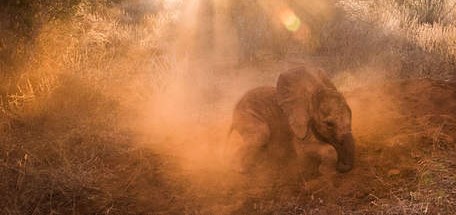 Orphans Project: At the heart of the Sheldrick Wildlife Trust’s conservation activities is the Orphans’ Project, which has achieved world-wide acclaim through its hugely successful elephant and rhino rescue and rehabilitation program.
Orphans Project: At the heart of the Sheldrick Wildlife Trust’s conservation activities is the Orphans’ Project, which has achieved world-wide acclaim through its hugely successful elephant and rhino rescue and rehabilitation program.
Aerial Surveillance: The Aerial Unit patrols daily to monitor wildlife and deter illegal activity, while offering rapid response assistance to anti-poaching activities and incidents of human-wildlife conflict in the Tsavo Conservation Area and Lamu District.
Anti Poaching: Ivory and rhino horn poaching have a devastating effect on Africa’s wildlife. Accompanied by armed KWS Rangers and supported by Aerial and Canine Units, last year 25 front-line teams patrolled 35,440 miles on foot, recovering and destroying 9,377 snares, seizing 120 weapons, and making 318 arrests.
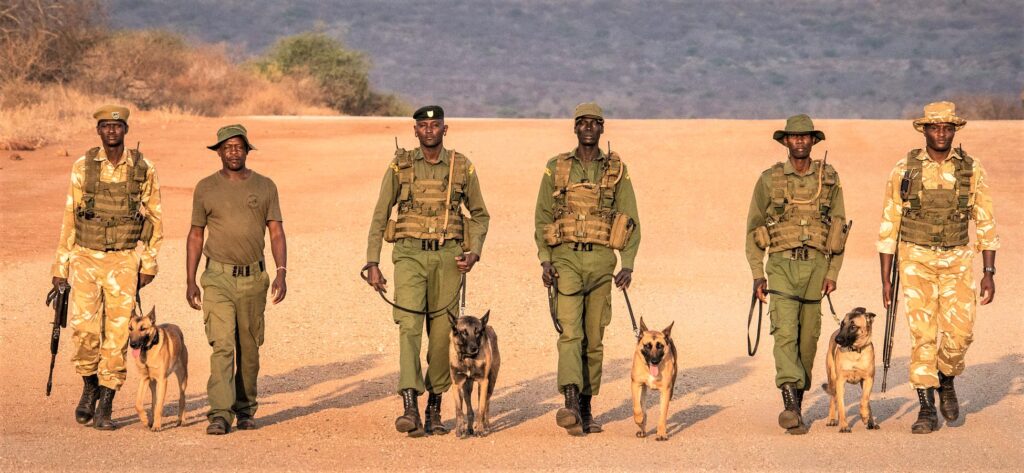 Canine Unit: Globally, the trade in illegal wildlife is estimated at $20 billion. Trained tracker dogs and their handlers detect illegal wildlife products, such as ivory, rhino horn, bushmeat, guns, and ammunition, as well as follow poachers’ tracks. Canines are able to detect the smallest trace of scent or footprints.
Canine Unit: Globally, the trade in illegal wildlife is estimated at $20 billion. Trained tracker dogs and their handlers detect illegal wildlife products, such as ivory, rhino horn, bushmeat, guns, and ammunition, as well as follow poachers’ tracks. Canines are able to detect the smallest trace of scent or footprints.
Veterinary Units: Six fully equipped Mobile Veterinary Units respond to wildlife emergencies from snares, spears, arrow and gunshot wounds, working in diverse habitats. 3,204 elephant cases have been treated, and 6,474 other wild animals.
Saving Habitats: Erecting and maintaining fencelines to secure wildlife areas and reduce human-wildlife conflict and providing financial support to empower community-led initiatives to protect areas of biodiversity, in 2020 2,019,480 acres of land were protected with partners, and 500,000+ trees planted.
Water for Wildlife: Construction of a dam outside Amboseli NP, drilling and maintaining 32 boreholes that operate on wind and solar energy in three NP’s, and operating 8 large-capacity water bowsers for emergency water relief are some of the ways SWT works to alleviate the horrific drought problems in Kenya today.
Community Outreach: Dedicated to educating and informing the younger generation about the positive impacts native wildlife can bring to their country, SWT funds more than 60 school field trips per year. Over 24,000 Kenyan school children attend the 11-12 daily mud bath at the Nairobi Orphanage every year.
Dame Daphne Sheldrick (1934-2018), founder of Sheldrick Wildlife Trust
» posted on Sunday, September 11th, 2022 by Linda Lou Burton
Face to Face
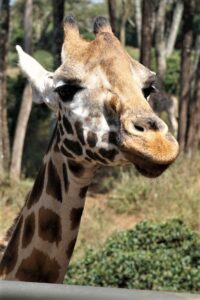 Linda Lou Burton posting from Nairobi, Kenya –Sunday morning in Nairobi and our Globus Tour begins today! It was a pre-safari day, a day for exploring Nairobi; and Rick and I were the only two signed up. Our Globus Guide for the day, Blethwell, and our driver, Daniel, met us in the lobby just at 9 AM, reviewed the day’s itinerary, and escorted us to our Globus 6-passenger transport. Our first stop: the Giraffe Centre.
Linda Lou Burton posting from Nairobi, Kenya –Sunday morning in Nairobi and our Globus Tour begins today! It was a pre-safari day, a day for exploring Nairobi; and Rick and I were the only two signed up. Our Globus Guide for the day, Blethwell, and our driver, Daniel, met us in the lobby just at 9 AM, reviewed the day’s itinerary, and escorted us to our Globus 6-passenger transport. Our first stop: the Giraffe Centre.
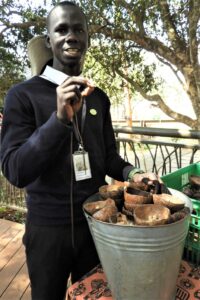 It was an 11-mile drive to the Centre on Duma Road, where our first directive was to “wash our hands.” Just by the front gate, sinks and sanitizers were part of the “allowing in” process. Then a walk up a winding ramp to a stop for a pellet-filled coconut shell (the green pellets are alfalfa, the tan are corn and molasses, guess which was the favorite!). “Hold the pellet between thumb and forefinger and lay it gently on the giraffe’s tongue. Do not lay the pellets out flat in your palm.”
It was an 11-mile drive to the Centre on Duma Road, where our first directive was to “wash our hands.” Just by the front gate, sinks and sanitizers were part of the “allowing in” process. Then a walk up a winding ramp to a stop for a pellet-filled coconut shell (the green pellets are alfalfa, the tan are corn and molasses, guess which was the favorite!). “Hold the pellet between thumb and forefinger and lay it gently on the giraffe’s tongue. Do not lay the pellets out flat in your palm.”
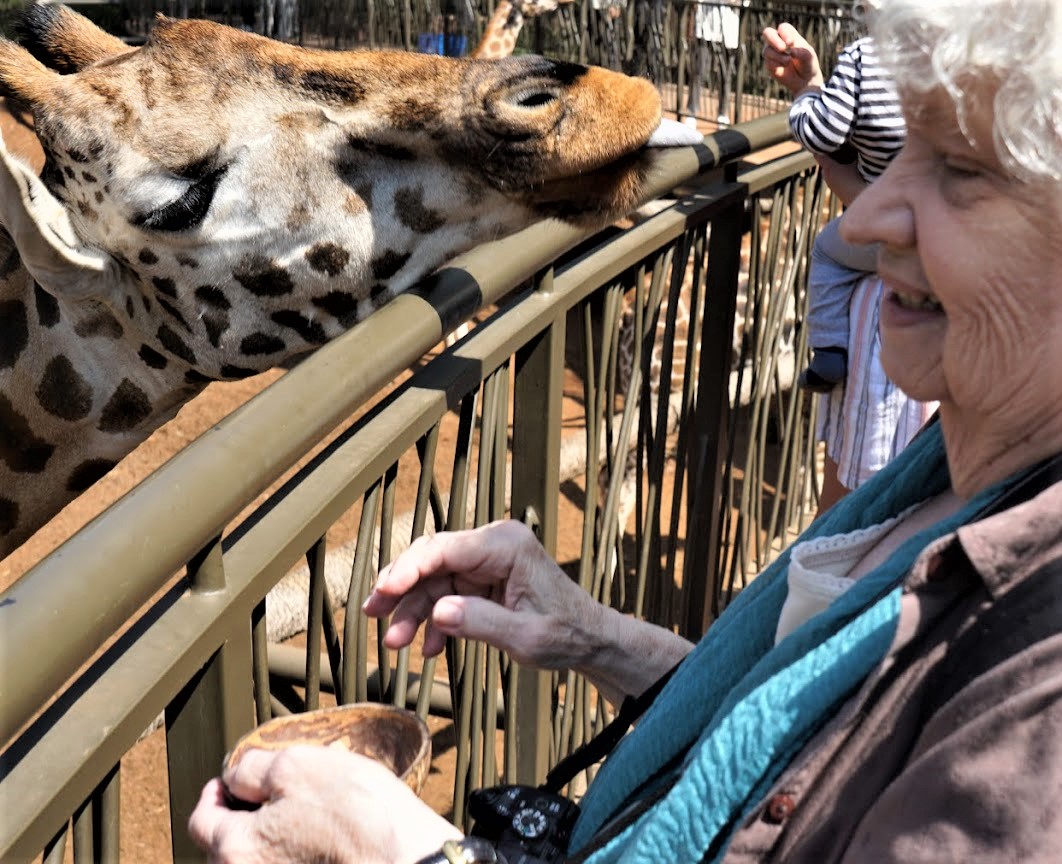
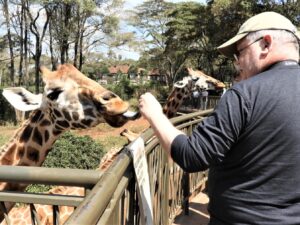
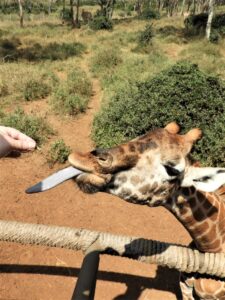 Armed with coconut shells and cameras, we stepped onto the platform that put us FACE TO FACE with the Long Tall Sallys of the animal world. First thing to note: these giraffes were polite but not shy as they fluttered those movie-star eyelashes, extended their long gray-velvet tongues, and downed our offered pellets. Everyone on the ramp was giggling, age no issue. A kid on his Daddy’s shoulders. A gray-headed granny. It was just plain fun.
Armed with coconut shells and cameras, we stepped onto the platform that put us FACE TO FACE with the Long Tall Sallys of the animal world. First thing to note: these giraffes were polite but not shy as they fluttered those movie-star eyelashes, extended their long gray-velvet tongues, and downed our offered pellets. Everyone on the ramp was giggling, age no issue. A kid on his Daddy’s shoulders. A gray-headed granny. It was just plain fun.
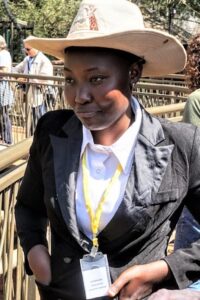 Eunice, the Ranger who was answering questions right and left, called out the names of each giraffe; told us of their good, and bad,
Eunice, the Ranger who was answering questions right and left, called out the names of each giraffe; told us of their good, and bad, 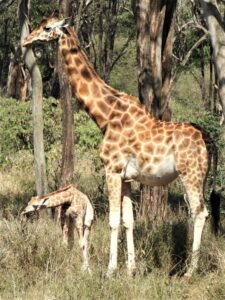 habits. She pointed to the mother and baby standing back under the trees. “The baby is so new we haven’t gotten close enough yet to know if it is male or female,” she told me. I studied Mama and Baby, commenting “A baby has a long way to fall, are they ever injured?”
habits. She pointed to the mother and baby standing back under the trees. “The baby is so new we haven’t gotten close enough yet to know if it is male or female,” she told me. I studied Mama and Baby, commenting “A baby has a long way to fall, are they ever injured?”
The answer: giraffes enter the world front legs and head first, followed by their body, and then back legs. Mama stands for the birth because – well the baby is BIG and its neck is LONG; the 6-foot drop from womb to ground snaps the umbilical cord, tears the birth sac open, and stimulates the baby to take its first breaths. Baby is up and walking within hours, ready to feed, and ready to run, if need be. This protected baby didn’t have a worry!
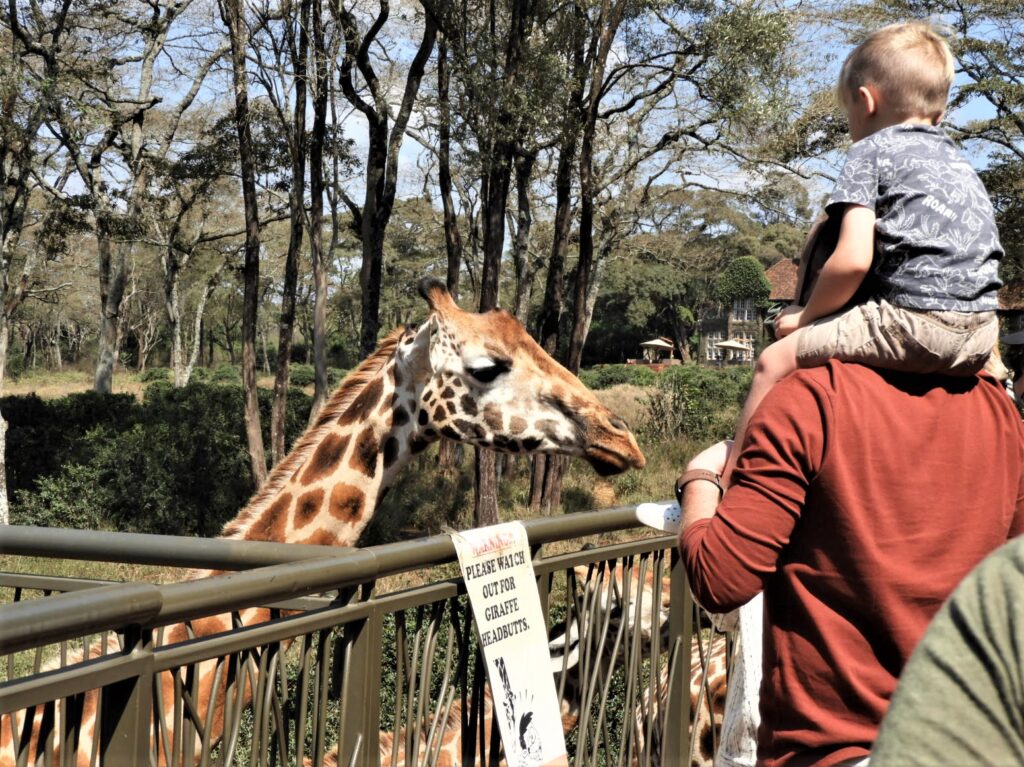 The Giraffe Centre is the creation of the African Fund for Endangered Wildlife (AFEW), a Kenyan non-profit organization. Its main purpose is to educate Kenyan school children and youth on their country’s wildlife and environment, as well as give local and international visitors an opportunity to come into close contact with the world’s tallest species.
The Giraffe Centre is the creation of the African Fund for Endangered Wildlife (AFEW), a Kenyan non-profit organization. Its main purpose is to educate Kenyan school children and youth on their country’s wildlife and environment, as well as give local and international visitors an opportunity to come into close contact with the world’s tallest species. 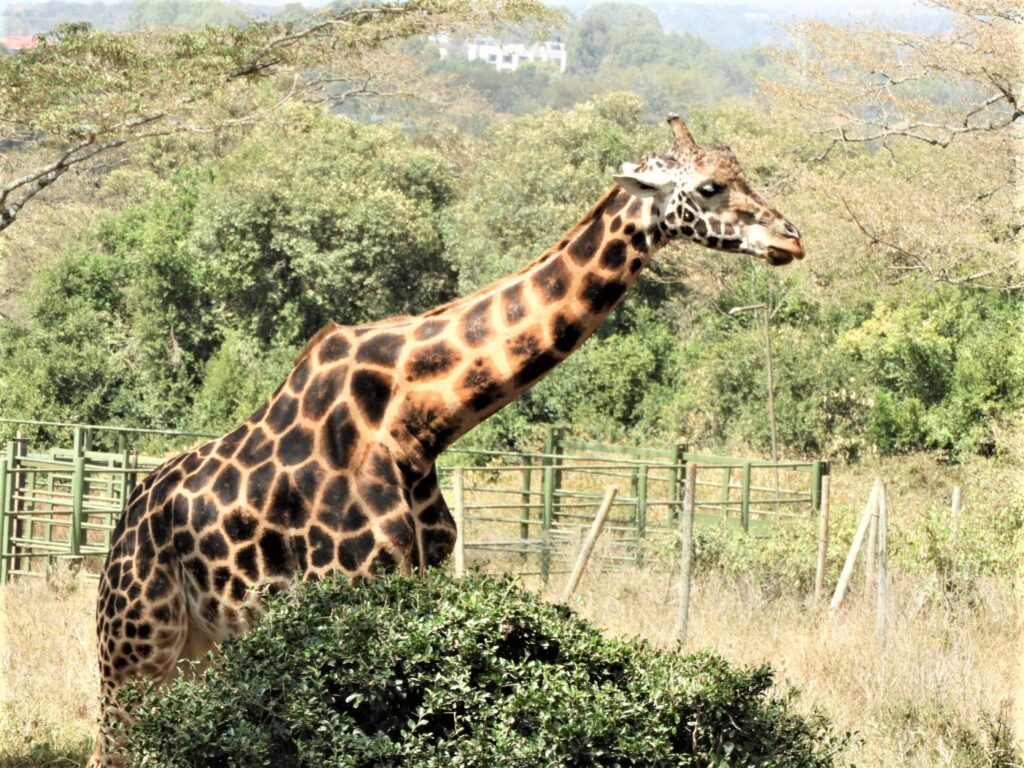
The AFEW was founded in 1979 by Jock Leslie-Melville, a Kenyan citizen of British descent, and his American-born wife, Betty, after discovering the sad plight of the Rothschild Giraffe, a subspecies of giraffe found only in the grasslands of East Africa. At the time, the animals had lost their habitat in Western Kenya, with only 130 of them left. Jock and Betty brought two young giraffes to their home in a Nairobi suburb, Langata, where they started a program of 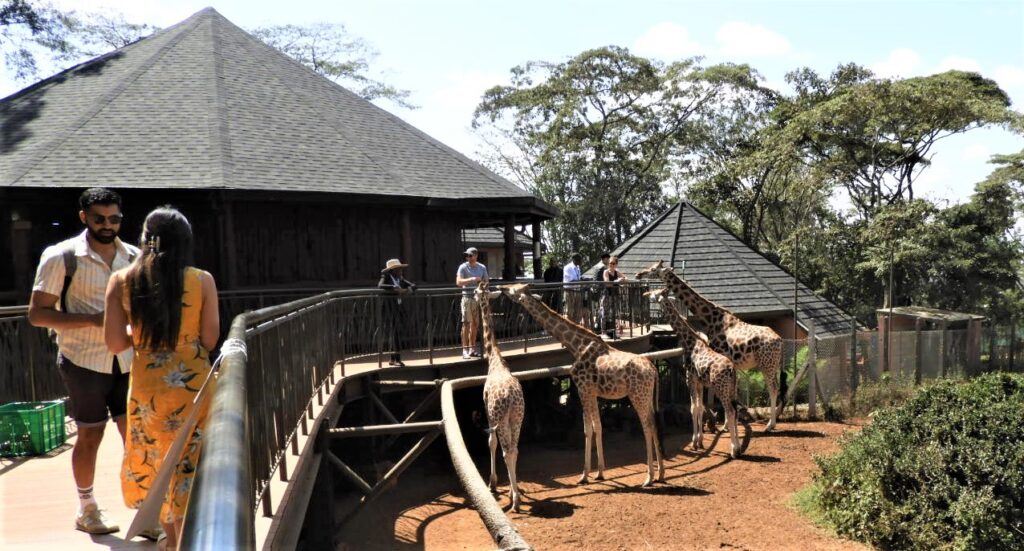 breeding giraffes in captivity. This is where the Centre remains today. In 1983, funds raised by AFEW USA helped build the Educational Centre on this 60-acre sanctuary. The Giraffe Centre opened its doors to the general public and students the same year. There are now over 300 Rothschild Giraffes living safely and breeding well in various Kenyan national parks.
breeding giraffes in captivity. This is where the Centre remains today. In 1983, funds raised by AFEW USA helped build the Educational Centre on this 60-acre sanctuary. The Giraffe Centre opened its doors to the general public and students the same year. There are now over 300 Rothschild Giraffes living safely and breeding well in various Kenyan national parks.
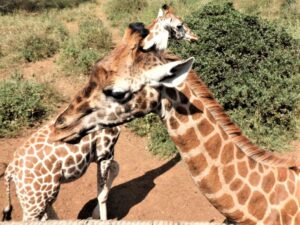 If you can’t make it to Nairobi, then go to the Centre’s website to learn more about the seven females — Betty, the oldest; Kelly, Daisy IV, Salma II, Margaret, Nandi, and Lilly — and the three males, Olerai, Mpingo, and Edd, 18 feet tall and the friendliest; he is father to all the calves. Keep up with the babies via the blogs. And oh yes, a warthog family lives there too! Here’s the link to the site, lots of video. They love donations, be generous.
If you can’t make it to Nairobi, then go to the Centre’s website to learn more about the seven females — Betty, the oldest; Kelly, Daisy IV, Salma II, Margaret, Nandi, and Lilly — and the three males, Olerai, Mpingo, and Edd, 18 feet tall and the friendliest; he is father to all the calves. Keep up with the babies via the blogs. And oh yes, a warthog family lives there too! Here’s the link to the site, lots of video. They love donations, be generous.
Giraffe Centre: https://www.giraffecentre.org/
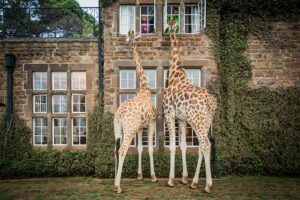 If you CAN go to Nairobi, and really want to get Face to Face, book a stay at the Giraffe Manor, a hotel which is part of the same property (see in background of other photos). In the second-floor suites of the Manor, those same giraffes Rick and I had so much fun feeding might just stick their head in your bedroom window and give you a wake-up call. This is what I call Totally Awesome. Stay in Jock’s Room, or Betty’s, or the Karen Blixen Suite. For a price! Put it on your Bucket List?
If you CAN go to Nairobi, and really want to get Face to Face, book a stay at the Giraffe Manor, a hotel which is part of the same property (see in background of other photos). In the second-floor suites of the Manor, those same giraffes Rick and I had so much fun feeding might just stick their head in your bedroom window and give you a wake-up call. This is what I call Totally Awesome. Stay in Jock’s Room, or Betty’s, or the Karen Blixen Suite. For a price! Put it on your Bucket List?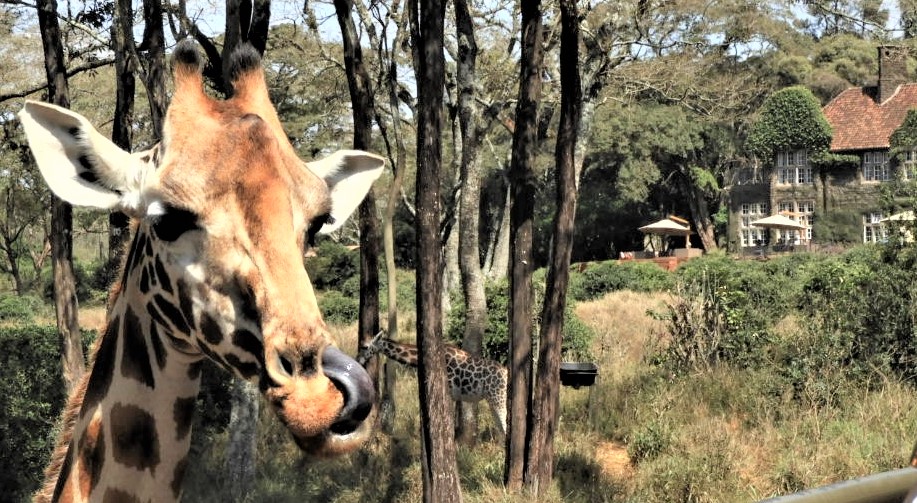
Giraffe Manor: https://www.thesafaricollection.com/properties/giraffe-manor/
Giraffes should be regarded as “intelligent, group-living mammals which have evolved highly successful and complex societies, which have facilitated their survival in tough, predator-filled ecosystems.”
» posted on Saturday, September 10th, 2022 by Linda Lou Burton
Barbed Wire Flowers?
Linda Lou Burton posting from Nairobi, Kenya –A free day! Strangely, even after missing all that sleep while wedged into a 16-inch space for more than 16-hours, we woke up feeling rather chipper. Maybe the excitement of finally BEING where we’d planned to be for so many months? A really, really difficult endeavor to pull off that we had, in fact, pulled off? And then, 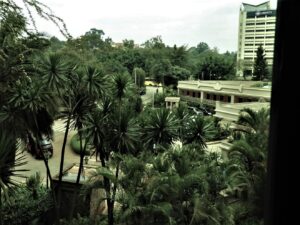 we heard the sound of a marching band! A parade? A football game? We ran to our window to see.
we heard the sound of a marching band! A parade? A football game? We ran to our window to see.
Our room was on the 4th floor overlooking the front entry drive, and though we could see a bus on the street, and Liberty Insurance building across, no band appeared. I’d studied Google maps as I plotted our trip, so knew that Nairobi Serena was a short distance from the city center, backing up to Central Park, 22 acres containing a large 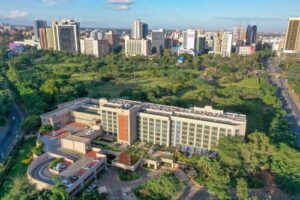 monument to Kenya’s first president, Jomo Kenyatta (1889-1978). I knew that Kenya’s Parliament House was a mile away, and that Kenyatta’s Mausoleum was near that. Of course we’d arrived the night before at Jomo Kenyatta International Airport, and the main street going by our hotel was – you guessed it – Kenyatta Avenue.
monument to Kenya’s first president, Jomo Kenyatta (1889-1978). I knew that Kenya’s Parliament House was a mile away, and that Kenyatta’s Mausoleum was near that. Of course we’d arrived the night before at Jomo Kenyatta International Airport, and the main street going by our hotel was – you guessed it – Kenyatta Avenue.
No doubt, we were in political territory! And with the inauguration of new president William Ruto looming in three days, after a hard-fought election that got really nasty and wound up in the hands of the Supreme Court. The OUTGOING (by a nose) president was the incumbent Uhuru Kenyatta, SON of Jomo, so as you might guess, emotions were running high! The 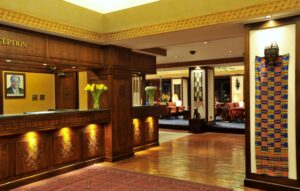 comments we got from Douglas the night before assured us of that. We decided to head for breakfast and ask a few questions about the weekend happenings. We stopped at the concierge desk on the way – “Is there a parade near here today?” we asked. “No, they’re just rehearsing for Tuesday’s inauguration,” was the answer. Ahh.
comments we got from Douglas the night before assured us of that. We decided to head for breakfast and ask a few questions about the weekend happenings. We stopped at the concierge desk on the way – “Is there a parade near here today?” we asked. “No, they’re just rehearsing for Tuesday’s inauguration,” was the answer. Ahh.
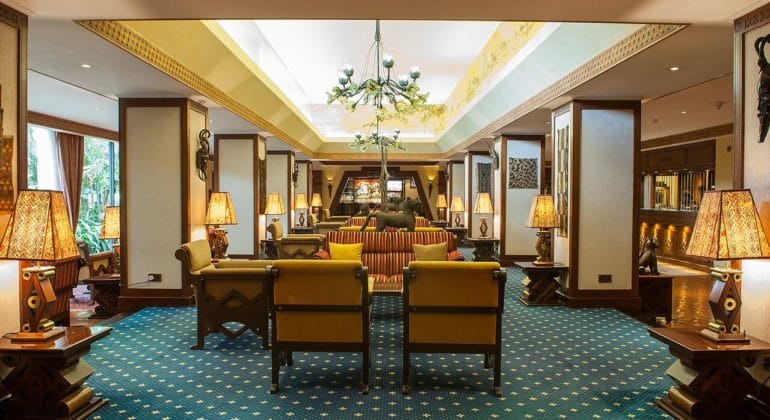 Nairobi Serena is a 5-star hotel with 190 rooms; the State Suite, with its own lobby and dining room, goes for $5,000 per night. We were at the OTHER end of the spectrum, but nevertheless got to share the white-uniformed doorman, the eloquent lobby areas, and the dining rooms, pool, and gardens. First stop, Cafe Maghreb, for an enormous buffet breakfast.
Nairobi Serena is a 5-star hotel with 190 rooms; the State Suite, with its own lobby and dining room, goes for $5,000 per night. We were at the OTHER end of the spectrum, but nevertheless got to share the white-uniformed doorman, the eloquent lobby areas, and the dining rooms, pool, and gardens. First stop, Cafe Maghreb, for an enormous buffet breakfast. 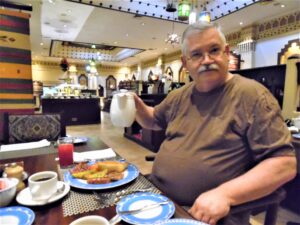 Is there any unique thing you can THINK of that you’d like for breakfast? It was there, spread out like the week’s wash over three levels – the cooking station at the top (omelet? crepes?); the main spread in the middle (meats, vegetables, fruits, juices, breads); and additional pampering on the lower level near the palm-surrounded pool. Service was elbow deep, meaning, someone always stood near, filling a glass, picking up a plate, inquiring as to our
Is there any unique thing you can THINK of that you’d like for breakfast? It was there, spread out like the week’s wash over three levels – the cooking station at the top (omelet? crepes?); the main spread in the middle (meats, vegetables, fruits, juices, breads); and additional pampering on the lower level near the palm-surrounded pool. Service was elbow deep, meaning, someone always stood near, filling a glass, picking up a plate, inquiring as to our 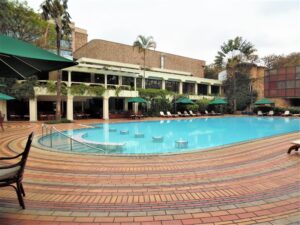 general happiness.
general happiness.
And then we wandered around the pool. It was a bit chilly, 60s maybe?, so no one was swimming. We admired the flowers, and listened to the sound of birds singing; it was a paradise, an Eden. We were feeling – no other words for it – spoiled rotten. Exorbitantly pampered.
We wandered through the Ethiopian-inspired bar, with its gold-trimmed 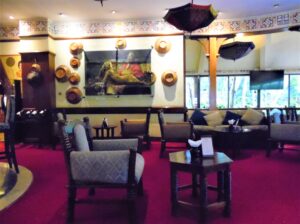 upside-down umbrellas hanging from the ceiling. We perused the gift shop, with African carvings and paintings for sale. I took a picture of the leopard-on-a-pillow (my first African animal spotting, I commented). We propped our feet up and dinked with our photos.
upside-down umbrellas hanging from the ceiling. We perused the gift shop, with African carvings and paintings for sale. I took a picture of the leopard-on-a-pillow (my first African animal spotting, I commented). We propped our feet up and dinked with our photos.
And then it was time for lunch. Back to the Maghreb, only this time we chose a table under the palms by the pool, offering menu choices. The vegetable soup was 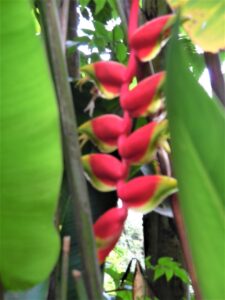 butternut squash. Better than ambrosia! A bird was singing in the palm tree beside us. He was HAPPY. I was happy. We were surrounded by flowers.
butternut squash. Better than ambrosia! A bird was singing in the palm tree beside us. He was HAPPY. I was happy. We were surrounded by flowers.
I noticed a bottle of Tabasco Sauce on our table; picked it up to examine it; yep, there it was – McIlhenny Co Tabasco Pepper Sauce, Avery Island, LA. I motioned to our server, a young woman who had been particularly diligent in seeing to our needs. I pointed to the label on the bottle. “This tabasco sauce was made not too far from where I live,” I told her. “It has come all the way here to Africa so you can enjoy it too.” She smiled, and a conversation began; where I lived, what it was like in my country; where she lived; how far she had to drive to come to work; her family. I made a connection! I was still tickled over the idea that the tabasco sauce sitting on my lunch table in Nairobi, Kenya was also sitting in my refrigerator back in Arkansas when our bill arrived. Our servers name appeared at the top, as usual. It was “Nubia.” “Good grief Rick, look at this!” I said. “Nubia” is the name of the young woman who is house sitting and caring for Katy Cat while I am away. The world is actually pretty small, when you consider.
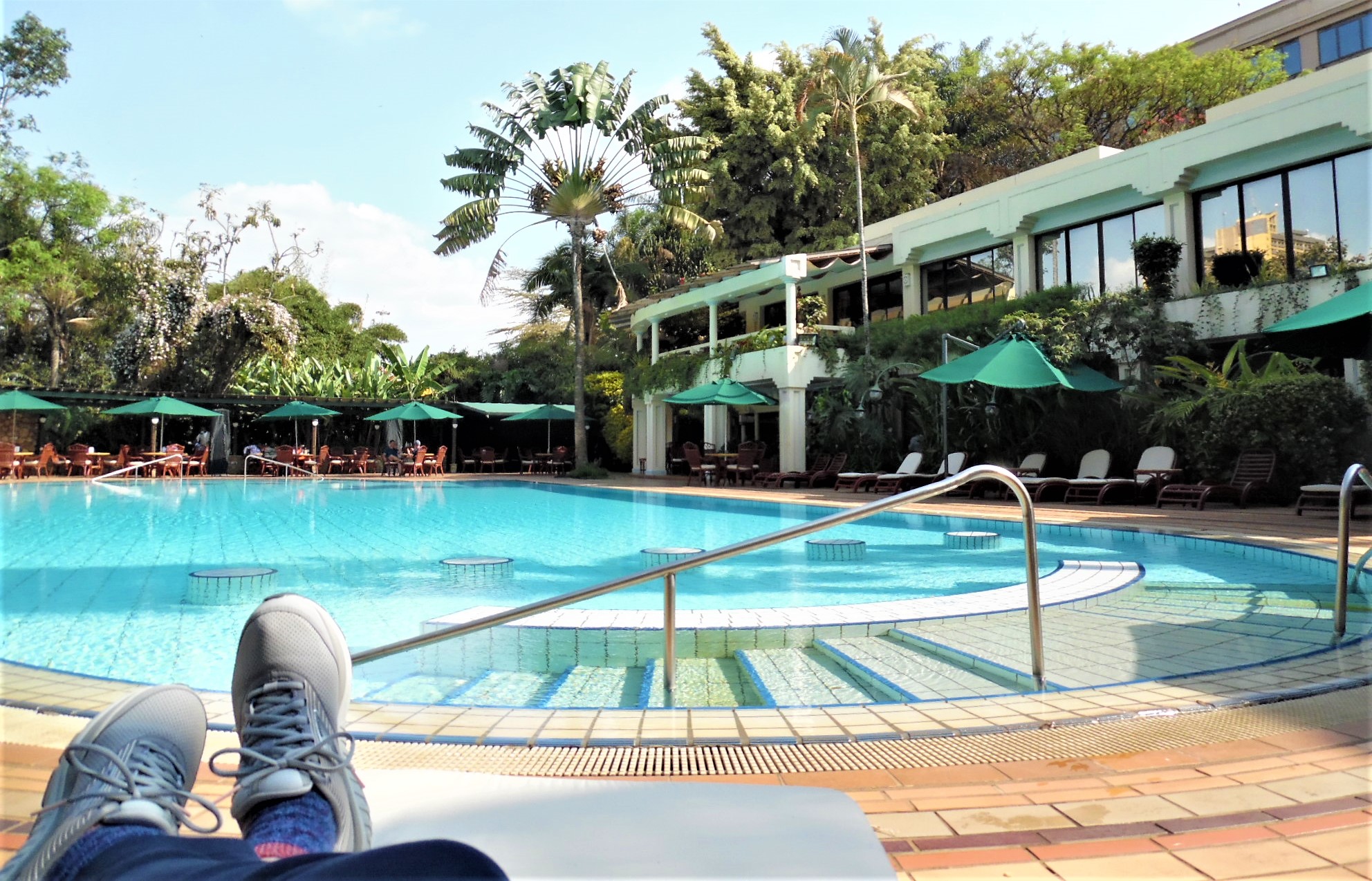
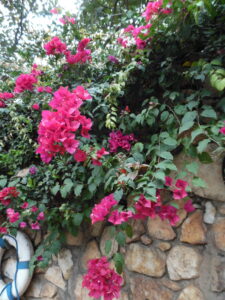 We wandered back to the pool, stretched out on the lounge chairs. We admired the flowers; the vines creeping over the beautiful stone walls. Rick got up to get more pictures. And then, a discovery. “I see barbed wire in here,” he said. He kept
We wandered back to the pool, stretched out on the lounge chairs. We admired the flowers; the vines creeping over the beautiful stone walls. Rick got up to get more pictures. And then, a discovery. “I see barbed wire in here,” he said. He kept 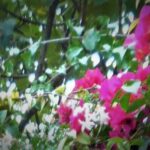 walking along the wall that separated the hotel grounds from Central Park. He took more pictures. “It is everywhere, we are surrounded by stone walls topped with beautiful flowers that cover coils of barbed wire inside.” I got up to look. Yes, it was true, the Serena grounds were a fortress; we recalled the locked gate, the guard with gun, the guard dog, all blocking our entry the night before until our identity was verified.
walking along the wall that separated the hotel grounds from Central Park. He took more pictures. “It is everywhere, we are surrounded by stone walls topped with beautiful flowers that cover coils of barbed wire inside.” I got up to look. Yes, it was true, the Serena grounds were a fortress; we recalled the locked gate, the guard with gun, the guard dog, all blocking our entry the night before until our identity was verified.
Our mood shifted. 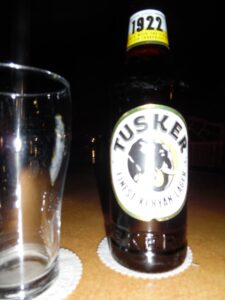 We spent our evening by the pool as well. The original plan was to celebrate in the fine dining room on the upper terrace; to dress up in our in our best duds and listen to the tinkling notes of the grand piano as we lived the high life. As the sky darkened and the birdsong quieted down, we chose instead to order pizza from the Pool Terrace Bar; to drink a Kenyan-brand Tusker beer instead of champagne; to get to bed early.
We spent our evening by the pool as well. The original plan was to celebrate in the fine dining room on the upper terrace; to dress up in our in our best duds and listen to the tinkling notes of the grand piano as we lived the high life. As the sky darkened and the birdsong quieted down, we chose instead to order pizza from the Pool Terrace Bar; to drink a Kenyan-brand Tusker beer instead of champagne; to get to bed early.
The real shock of barbed-wire walls would not be revealed until the next day however, when we ventured into the city.
Nairobi Serena Hotel, Kenyatta, Avenue: https://www.serenahotels.com/nairobi
» posted on Friday, September 9th, 2022 by Linda Lou Burton
Attitude at Latitude
Linda Lou Burton posting from Little Rock, Arkansas; Chicago, Illinois; Frankfurt, Germany; and Nairobi, Kenya –Are climate and manners related? I mean – are people in warmer climes just naturally friendlier and warmer? Now, don’t get huffy about stereotyping, just listen to this.
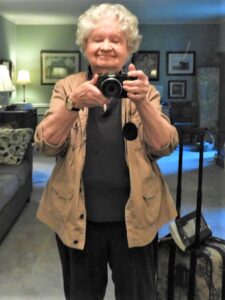 Son Rick and I couldn’t do the “on-line check-in” that United was asking us to do first thing Thursday morning. The SYSTEM said we had to have a seat number to check in online, but the system wouldn’t give us a seat number until we entered all health information from our pre-school vaccinations to the latest COVID booster. Holy crap! We both had our QR Codes telling all; we had all our Visas; we had our Yellow Fever Card officially stamped by state health officials. But no matter what we scanned or what lengthy numbers we entered, some unknown gremlin would not RECOGNIZE us. You know that early-morning stomach knot when technology blocks tenacity? Best to get to the airport early and ask a HUMAN for help.
Son Rick and I couldn’t do the “on-line check-in” that United was asking us to do first thing Thursday morning. The SYSTEM said we had to have a seat number to check in online, but the system wouldn’t give us a seat number until we entered all health information from our pre-school vaccinations to the latest COVID booster. Holy crap! We both had our QR Codes telling all; we had all our Visas; we had our Yellow Fever Card officially stamped by state health officials. But no matter what we scanned or what lengthy numbers we entered, some unknown gremlin would not RECOGNIZE us. You know that early-morning stomach knot when technology blocks tenacity? Best to get to the airport early and ask a HUMAN for help.
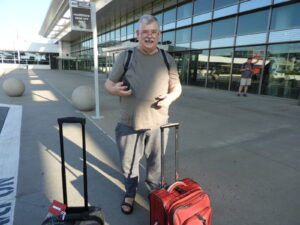 I snapped a goodbye photo and said one last farewell to Katy Cat, then we were gone. Uber dropped us at Little Rock’s Clinton National at 8:30 am and we bravely approached a CLOSED section of the United counter, where we spotted a young woman just getting ready to open up. No line. I leaned on my cane, and smiled at her. She smiled back. I explained our predicament, laying out all our official documents. Rick showed her his phone, with all the United refusals to recognize us. She made suggestions, then took the phone herself. She called someone else over to look. Now, two heads trying to figure it out.
I snapped a goodbye photo and said one last farewell to Katy Cat, then we were gone. Uber dropped us at Little Rock’s Clinton National at 8:30 am and we bravely approached a CLOSED section of the United counter, where we spotted a young woman just getting ready to open up. No line. I leaned on my cane, and smiled at her. She smiled back. I explained our predicament, laying out all our official documents. Rick showed her his phone, with all the United refusals to recognize us. She made suggestions, then took the phone herself. She called someone else over to look. Now, two heads trying to figure it out.
“You have everything you need,” she said. “There is NO REASON this won’t go through!” A male employee approached, with a box of donuts in hand, a morning treat he was bringing to share with our kindly helper. Hugs all around, thank yous for the donuts, and soon, the man was drawn into our dilemma too. FIVE OF US, shaking our heads. AND THEN, our kindly helper started clicking away on her keyboard, and printed out four boarding passes. “Here,” she said. “Don’t worry about it. You are now checked in all the way through Chicago and Frankfurt to Nairobi.”
“What did you do?” I asked. “I overrode the system,” she said. “I’ve seen your documents. Now, have a great trip!” Rick and I just stared, bug-eyed. And then, RELIEF! We thanked our kindly helper. “Please come around the counter,” I said to her. “I want to give you a hug!” She did. I did. The man who’d brought the donuts came around too. More hugs. More thank yous. “You are an inspiration to me,” he said. “Going on such an adventure at 83!” He admitted to being in his 60s. “I thought I was too old to travel,” he said, “but you are proof I’m not!”
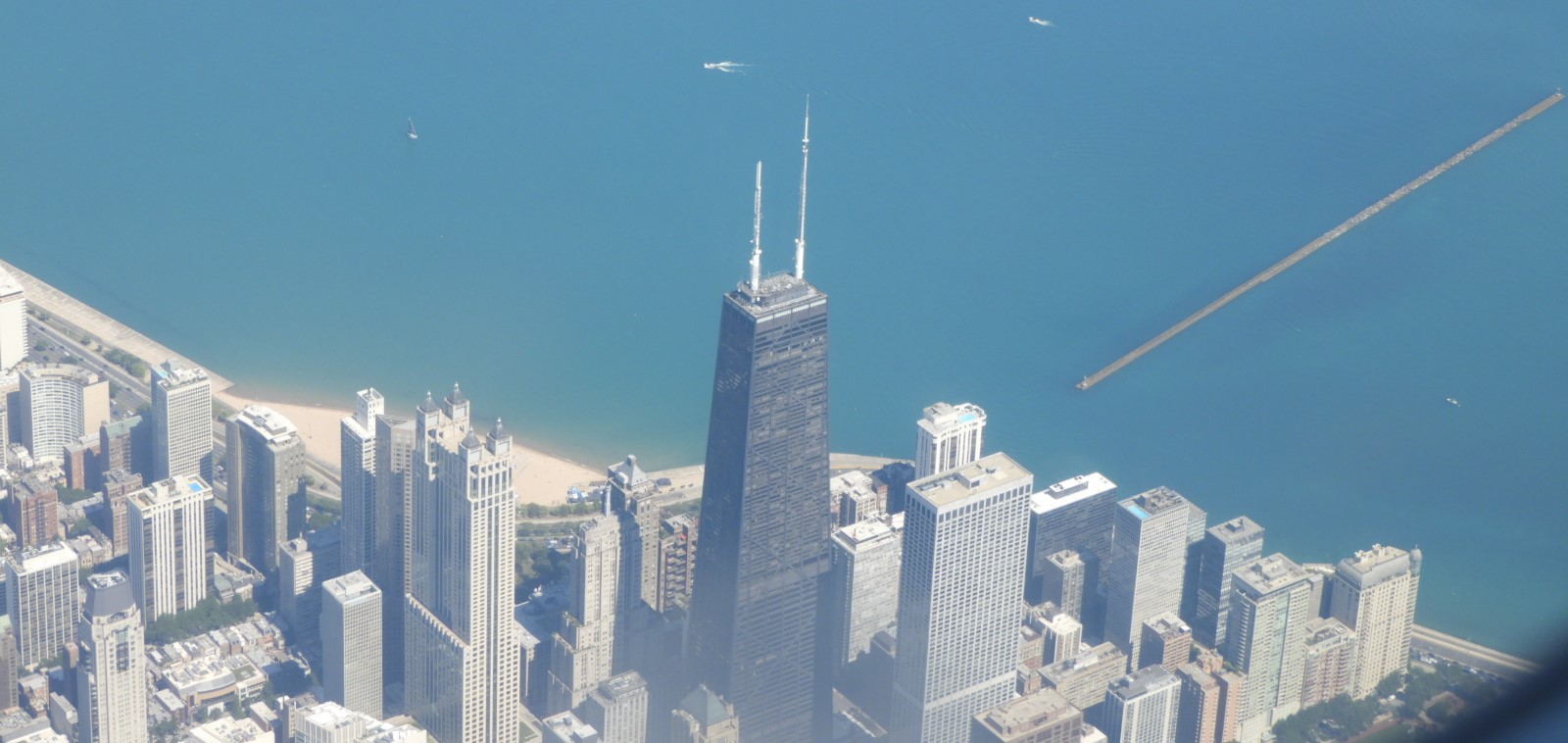 I’d asked for wheelchair assistance for both myself, and for Rick, who is in his 60s and almost as bumbly as me. We had done the advance work of getting a KTN (Known Traveler Number) which SHOULD have made getting through security easier; at least, in the US. Still, it took a while, but our loyal Wheelchair Assistants kept pushing our chairs and pulling our bags, helping with absolutely everything, till we reached our gate as Approved Travelers. Our short flight north to Chicago’s O’Hare was pleasant – from my window seat I got shots of the
I’d asked for wheelchair assistance for both myself, and for Rick, who is in his 60s and almost as bumbly as me. We had done the advance work of getting a KTN (Known Traveler Number) which SHOULD have made getting through security easier; at least, in the US. Still, it took a while, but our loyal Wheelchair Assistants kept pushing our chairs and pulling our bags, helping with absolutely everything, till we reached our gate as Approved Travelers. Our short flight north to Chicago’s O’Hare was pleasant – from my window seat I got shots of the 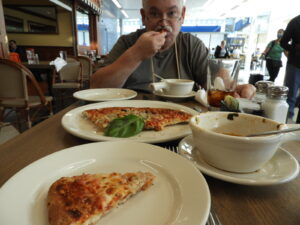 Mississippi River, then the Chicago skyline, and Lake Michigan. A beautiful day! Wheelchair Assistance was great there too; brisk, lively conversation as we were wheeled down corridors, onto trains, and through more security proving our travel worthiness. No hugs, but we were taken to our gate in plenty of time to meander to a restaurant for some Chicago pizza.
Mississippi River, then the Chicago skyline, and Lake Michigan. A beautiful day! Wheelchair Assistance was great there too; brisk, lively conversation as we were wheeled down corridors, onto trains, and through more security proving our travel worthiness. No hugs, but we were taken to our gate in plenty of time to meander to a restaurant for some Chicago pizza.
Then it was time to board our Lufthansa flight to Frankfurt. Our boarding passes showed seats 47E and 47F, the worst of the worst, smack dab in the middle of the middle and far from 1st Class spaciousness. Plus we had to enter down different aisles. As I pushed my bag along (we were allowed one bag under 33 pounds and one backpack on this Globus Safari) the aisle got narrower and narrower. I finally reached row 47, where an attendant, dressed in a spiffy Lufthansa uniform complete with hat and heels, was standing.
“You have to put that bag UP,” she said brusquely. “ I need some help,” I answered (remember, Rick was in the other aisle, four seats away). “Well, I can’t help you,” she said. “That bag looks HEAVY.” “It is too heavy for me,” I answered. “I can’t lift it above my head.” (Yes, I had my cane in one hand, and my backpack on my back.) She angrily took my bag and shoved it into the overhead. “I am NOT supposed to do this!” she shouted. “I have a BAD BACK.”
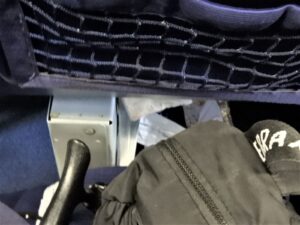 I thanked her for her help and took my seat, climbing over the aisle seat to a seat that had a metal BOX installed under the seat in front. There was no place to store my backpack! No foot room! About that time Rick arrived via the other aisle, as the attendant complained to one of her co-staff “People ask ME to lift things! I have a BAD BACK. People are so RUDE to me! We are NOT supposed to lift anything heavy. Then we get hurt and can’t work and they dock us our pay! It isn’t FAIR to ask us to LIFT THINGS!”
I thanked her for her help and took my seat, climbing over the aisle seat to a seat that had a metal BOX installed under the seat in front. There was no place to store my backpack! No foot room! About that time Rick arrived via the other aisle, as the attendant complained to one of her co-staff “People ask ME to lift things! I have a BAD BACK. People are so RUDE to me! We are NOT supposed to lift anything heavy. Then we get hurt and can’t work and they dock us our pay! It isn’t FAIR to ask us to LIFT THINGS!”
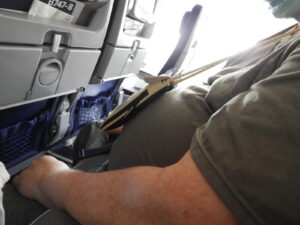 Rick and I just stared at each other, as the plane continued to fill. He did have foot room, but barely room to squeeze his elbows between the arm rests. And NO belly room! This was to be our world for the next 8 hours. We shuddered, and gritted our teeth.
Rick and I just stared at each other, as the plane continued to fill. He did have foot room, but barely room to squeeze his elbows between the arm rests. And NO belly room! This was to be our world for the next 8 hours. We shuddered, and gritted our teeth.
At least we had a screen, with games to play and movies to watch. However, we were instructed to wear our MASKS for the entire flight. I put myself into ENDURANCE MODE, playing the same Trivia Game answering the same Trivia Questions, over and over. I memorized ALL the answers. (Yes, the Orinoco River is in Venezuela.) No more contact with our attendants except during what was called “The Dinner Hour.” I had let my mask slide off one ear by then. “PUT ON YOUR MASK!” the attendant shouted, withholding my COLD FOOD package until I did.
And yet, we made it to Frankfurt. Daylight Friday morning in Germany. There was one wheelchair waiting outside the door of the plane. I inquired about the requested assistance for two. A tall, pale woman in uniform said, “I’ll take to you it.” She PUSHED the single wheelchair up the ramp, instructing me to walk behind her. I said, “If you are going to push the wheelchair, may I sit down in it?” “Just WAIT,” was her answer. Eventually we reached an elevator, and went up a floor. “You don’t have to walk much farther,” she said, holding tight to the empty wheel chair. We reached the main hallway and she directed us to a waiting area. “Sit there,” she said. “We don’t do wheelchairs.” And she pushed the empty wheelchair away.
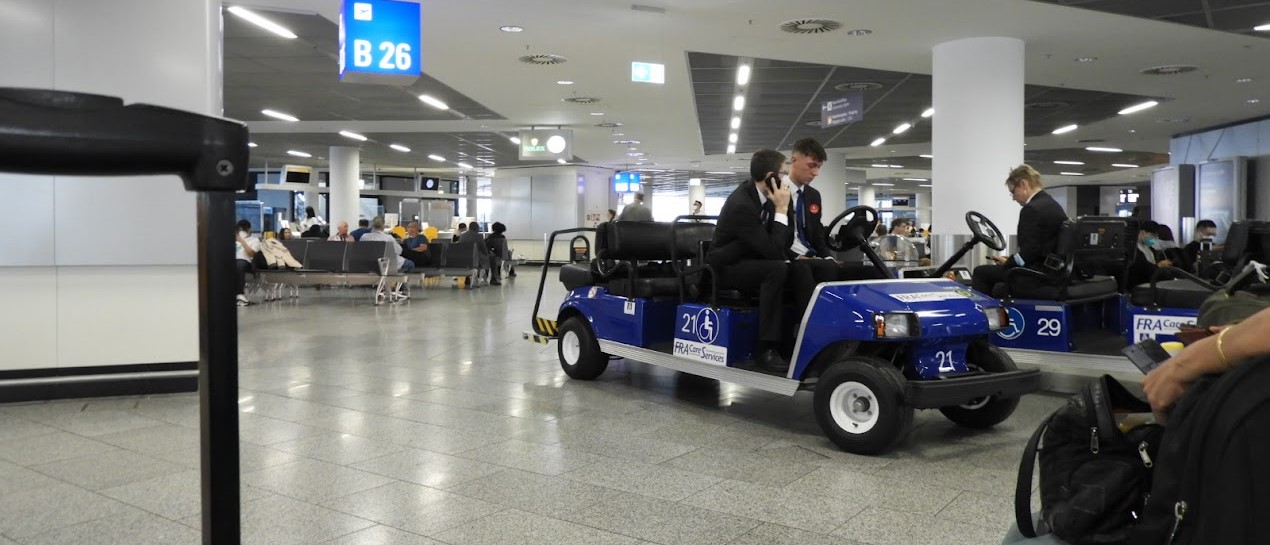 Two young men driving a cart approached, spiffy in black suits, skinny ties, short haircuts. “We’ll drive you to the bus,” was their instruction. Several more cart switches, drivers, transfers to a bus, a long drive to a different area, listening to employees discussing with each other the atrocities of work. Bragging about the efficiency of Frankfurt’s airport over anything else in Europe.
Two young men driving a cart approached, spiffy in black suits, skinny ties, short haircuts. “We’ll drive you to the bus,” was their instruction. Several more cart switches, drivers, transfers to a bus, a long drive to a different area, listening to employees discussing with each other the atrocities of work. Bragging about the efficiency of Frankfurt’s airport over anything else in Europe.
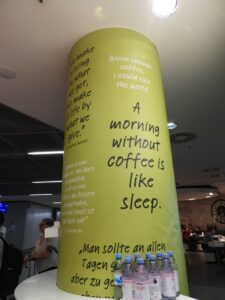 We were finally deposited at the gate for our Nairobi flight. We were starving! We took turns watching our luggage as we found restrooms. Then we began looking for food, or at least, COFFEE. One small shop, near. At least fifty people in line. A barista. Rows of coolers with drinks and sandwiches.
We were finally deposited at the gate for our Nairobi flight. We were starving! We took turns watching our luggage as we found restrooms. Then we began looking for food, or at least, COFFEE. One small shop, near. At least fifty people in line. A barista. Rows of coolers with drinks and sandwiches.
I approached the barista. “Is the line for all purchases, or is it the coffee line?” was my question. “The line is the line,” was the answer. “Now, go get in it, lady!”
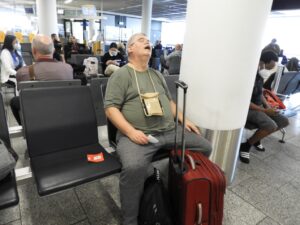 “I just need a cup of water,” I said. She handed me an empty cup and pointed. “There’s a fountain over THERE.”
“I just need a cup of water,” I said. She handed me an empty cup and pointed. “There’s a fountain over THERE.”
I found the fountain. I got some lukewarm water. I took my morning meds. Rick and I agreed – we’ll never fly Lufthansa again.
Of course, we had to. We had another 8 hours of Lufthansa from Frankfurt to Nairobi! Once again, we had middle-of-the-middle seats. Once again, we had crappy food. I did have room to put my feet, and our screens were better for gaming and for watching our progress as we flew south over the vast continent of Africa.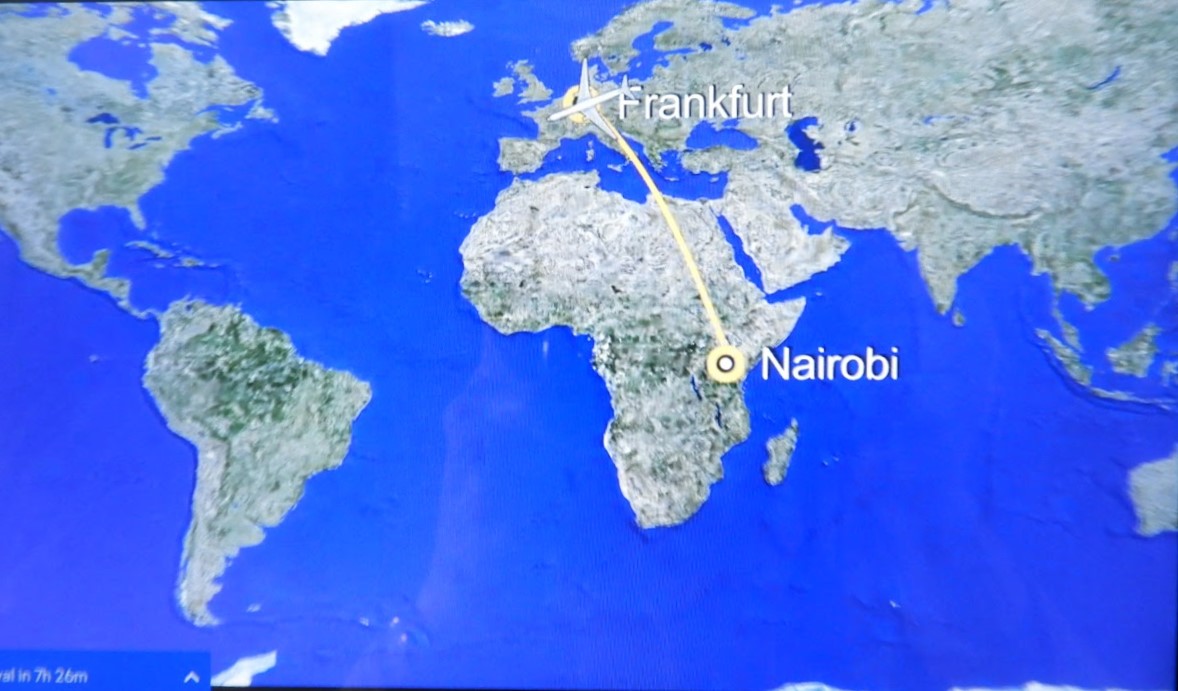
And then we landed in Nairobi, 70 miles SOUTH of the Equator. Our Wheelchair Assistants were there! “We have TRANSPORT to our hotel,” I told our Assistants. “Globus Tours.” We were rapidly wheeled through all the customs and security areas, how could there be so many SMILES? Smiles everywhere! Excitement! Welcome to Kenya! Welcome! Welcome!
The outside door of Jomo Kenyatta Airport! Hundreds of SIGNS waving. We finally spotted OUR transport vehicle, our driver.
 “My name is Douglas!” he said, in greeting. “Jambo! Welcome to Kenya!” He instructed our Assistants as to where to push our wheelchairs. He pulled his van to that spot. He helped us in, made sure our luggage was loaded. We told our Assistants goodbye, (large tip to each). Our energy level popped up about 50 percent, even though 30 hours had passed since we started at Clinton National. We were finally here!
“My name is Douglas!” he said, in greeting. “Jambo! Welcome to Kenya!” He instructed our Assistants as to where to push our wheelchairs. He pulled his van to that spot. He helped us in, made sure our luggage was loaded. We told our Assistants goodbye, (large tip to each). Our energy level popped up about 50 percent, even though 30 hours had passed since we started at Clinton National. We were finally here!
It was a 30-minute drive to Nairobi Serena Hotel. It was 10 PM, dark. Strange territory. But Douglas was all lightness, and cheer. “There are THREE WORDS you MUST know in Kenya!” he told us. “Jambo is the most important. It means HELLO!” He made us say it, back and forth. “The next most important is Asante, which is THANK YOU! And last, Karibu which means WELCOME. You can use it to welcome someone, as I welcome YOU, or, to say You are welcome, if someone has thanked you with Asante.”
We practiced, as we rode along. Douglas pointed out the sights. “Nairobi has a NATIONAL PARK within the city limits,” he said. “That is part of it to your left. Look for zebras! They are easy to spot at night.” We looked, but saw only darkness under the trees. Still, good to know. Douglas told us about the 42 tribes in Kenya. “I am Kikuyu,” he said, and our new PRESIDENT is Kikuyu. He will be inaugurated Tuesday! We are so happy to have one of ours in office now. I have SUCH HOPE for our country!” He went on to tell about the scarcity of jobs in Kenya, and how the new President is promising to increase opportunities for Kenyans.
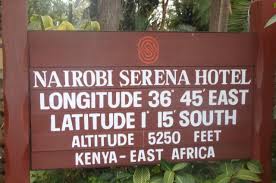 And then, we pulled into the driveway of Nairobi Serena Hotel. Douglas gave the necessary paperwork to the guard, the gate opened, we pulled to the entry. A doorman in a gold-trimmed white uniform opened the door of our van.
And then, we pulled into the driveway of Nairobi Serena Hotel. Douglas gave the necessary paperwork to the guard, the gate opened, we pulled to the entry. A doorman in a gold-trimmed white uniform opened the door of our van.
“Jambo!” he said. “Karibu!”
I felt right at home.
“I have an idea for my first post,” I said to Rick, as we rested in the lobby while Douglas got us checked in. “I’m going to name it Attitude at Latitude.”
FYI Airports
- Clinton National Airport, Little Rock: https://www.clintonairport.com/, serves abt 2 million passengers annually
- O’Hare International Airport, Chicago: https://www.flychicago.com/ohare/home/pages/default.aspx serves abt 54 million passengers annually
- Frankfurt Airport, Germany: https://www.frankfurt-airport.com/de.html serves abt 25 million passengers annually
- Jomo Kenyatta International Airport, Nairobi, Kenya: https://www.nairobi-airport.com/ serves abt 7 million passengers annually
» posted on Wednesday, September 7th, 2022 by Linda Lou Burton
Keeping In Touch
Linda Lou Burton posting from Little Rock, Arkansas – The days of waiting months for the slow boat to round the Horn with the mail are gone. We have cell phones now, so the main obstacle to communicating with someone on another continent is the time difference.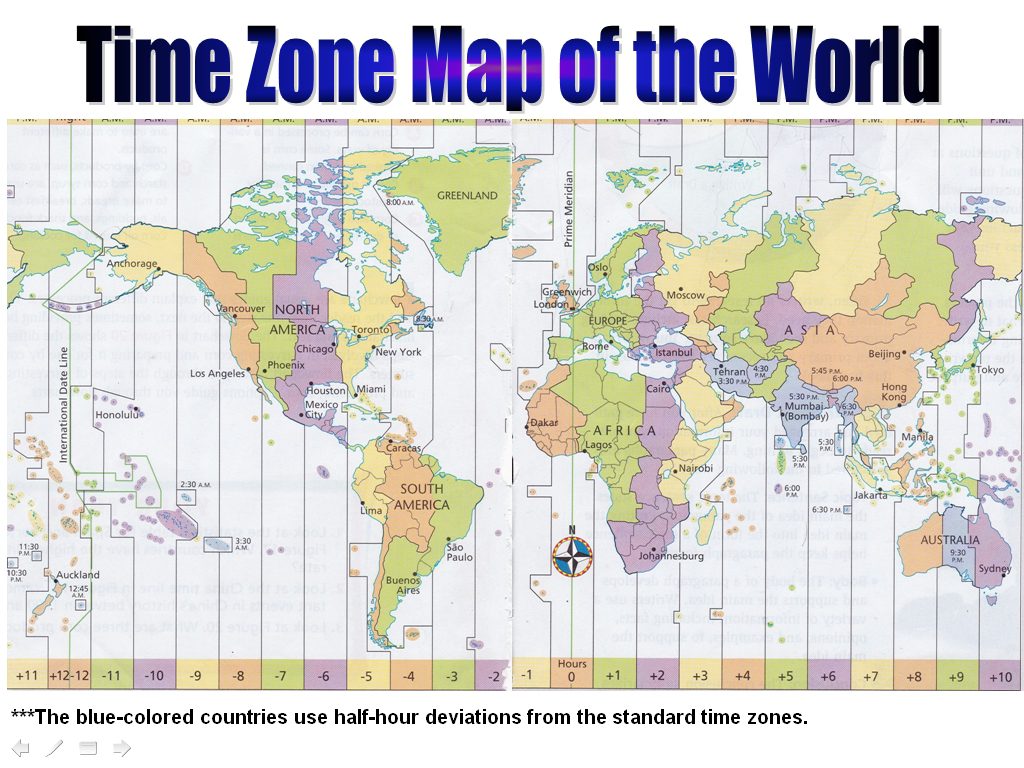
There are Time Converter websites, and Time Clock apps, if you can’t do the math about the GMT + or -. No point in calling someone in the middle of their sleepy time. So know that first. I live in Arkansas, smack in the Central Time Zone along with Chicago, and Houston. When we get to Kenya, and Tanzania, we’ll be on the same time as Moscow, and Madagascar. In Frankfurt, and Zurich, where we change planes, we’ll be in sync with Rome, and when in Iceland, well, it’s all too confusing, the way the powers-that-be have set it up with those crooked lines. Just Google it.
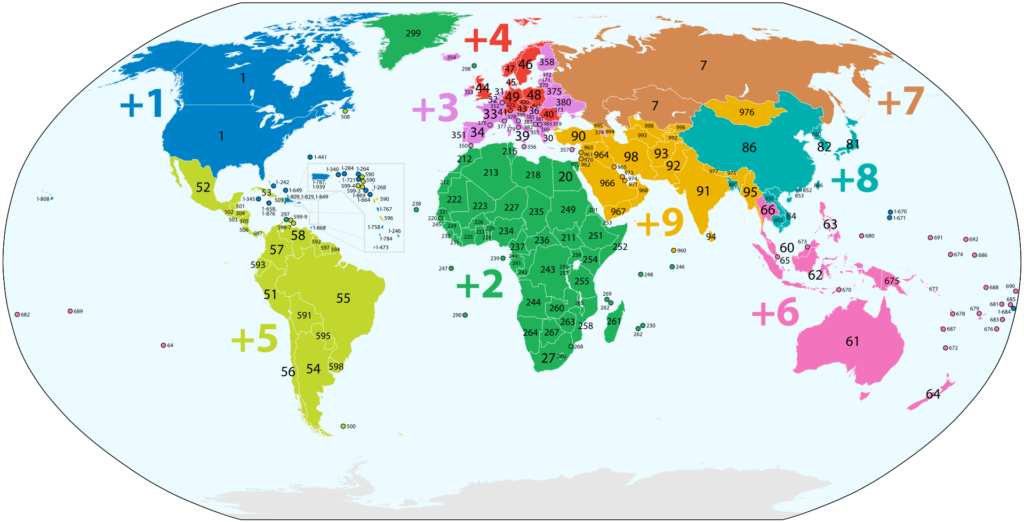 And then there’s the matter of Country Calling Codes. Yes, there is an International Telecommunication Union (the ITU) and member countries are assigned their own special number. The USA is #1. Remember that. Kenya is 254, Tanzania is 255, and Iceland is 354. You have to get through to the country before dialing the number of the place within the country. But oh, you have to dial OUT of the country you’re in before you can even do that. That number is 011. So, calling from the US to our hotel in Nairobi is 011-254-732124000. Or let your Android app figure it out.
And then there’s the matter of Country Calling Codes. Yes, there is an International Telecommunication Union (the ITU) and member countries are assigned their own special number. The USA is #1. Remember that. Kenya is 254, Tanzania is 255, and Iceland is 354. You have to get through to the country before dialing the number of the place within the country. But oh, you have to dial OUT of the country you’re in before you can even do that. That number is 011. So, calling from the US to our hotel in Nairobi is 011-254-732124000. Or let your Android app figure it out.
Lastly, it’s wise to know how to contact the U S Embassy in other countries, in case of some horrid disaster or unpredictable event when you can’t get through to us at all. Like maybe another volcano erupting in Iceland, only this time really HUGE, like the Mt St Helen’s blow-up in 1980 just as we were moving to Seattle.
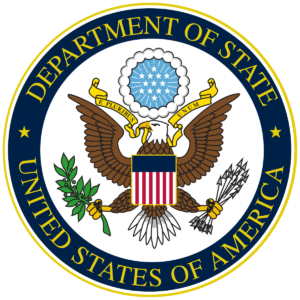 The US Department of State likes to look after its citizens when they travel; we’re registered with our Embassy in each of the three countries we’re visiting – they know when to expect us, are available to help us with any difficulties we may experience while there, and know how to get in touch with our family should the need arise.
The US Department of State likes to look after its citizens when they travel; we’re registered with our Embassy in each of the three countries we’re visiting – they know when to expect us, are available to help us with any difficulties we may experience while there, and know how to get in touch with our family should the need arise.
- KENYA: U.S. Embassy Nairobi, United Nations Avenue Nairobi, P. O. Box 606 Village Market, 00621 Nairobi, Kenya, 254 20 363-6000
- TANZANIA: U.S. Embassy in Dar es Salaam, 686 Old Bagamoyo Road, Msasani, Dar es Salaam, Tanzania, 255-22-229-4000
- ICELAND: U.S. Embassy in Reykjavik, Laufásvegur 21, 101 Reykjavík, 354 595 2200.
There you have it, we’re only a phone call away. Just don’t wake me up, please.
» posted on Monday, September 5th, 2022 by Linda Lou Burton
Warm Puppies
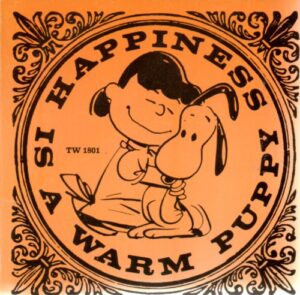 Charles Schulz, who had a knack for explaining the obvious, once wrote a book about happiness. Remember Happiness is a Warm Puppy? It doesn’t take more description than that to know what he’s talking about! Just saying those words makes you feel happy, unless you’re really allergic to dogs, or once was terrorized by a German shepherd.
Charles Schulz, who had a knack for explaining the obvious, once wrote a book about happiness. Remember Happiness is a Warm Puppy? It doesn’t take more description than that to know what he’s talking about! Just saying those words makes you feel happy, unless you’re really allergic to dogs, or once was terrorized by a German shepherd.
For the last ten years, statistical PROOF of happiness has been the goal of a group of learned, detail-specific folks who have been asking questions and analyzing data in 150 countries. And producing The World Happiness Report, giving us a picture of our global joy, or unrest.
What exactly do they consider? Some basic things you’d expect based on where you live: life expectancy in your country, GDP per capital in terms of purchasing power, freedom to make choices about what you do with your life, perceptions of corruption in your government, and amount of social support. Personal attitudes and experiences come into play as well: did you do something yesterday that made you laugh? Did you do something interesting, or learn something new? Did you donate money to a charity? Do you have friends you can count on?
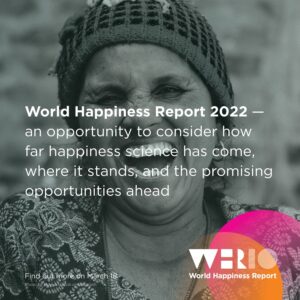 I won’t get into the statistical methods used, or the pages and pages (and pages) of data, but here’s a link to the entire project: https://worldhappiness.report/ and I encourage you to take a look. It’s fascinating! This year in particular, because they focused on the impact of COVID. With the world entering the third year of the pandemic, the report has three areas of focus in 2022: looking back; looking at how people and countries are doing in the face of COVID; and looking ahead to how the science of well-being is likely to evolve in the future.
I won’t get into the statistical methods used, or the pages and pages (and pages) of data, but here’s a link to the entire project: https://worldhappiness.report/ and I encourage you to take a look. It’s fascinating! This year in particular, because they focused on the impact of COVID. With the world entering the third year of the pandemic, the report has three areas of focus in 2022: looking back; looking at how people and countries are doing in the face of COVID; and looking ahead to how the science of well-being is likely to evolve in the future.
On the positive side, the most remarkable change was the global upsurge in benevolence in 2021. In every global region, there have been large increases in the proportion of people who give money to charity, help strangers, and do volunteer work. COVID also demonstrated the crucial importance of trust for human well-being. Deaths from COVID during 2020 and 2021 were markedly lower in those countries with higher trust in public institutions, and where inequality is lower.
The happiest countries in 2022? Finland, Denmark, Iceland, Switzerland, and the Netherlands make up the Top Five. The US came in at #16 – despite our low rankings in safety, we’re a country with a high life expectancy (78 for men, 83 for women), and despite our perceptions of too-low wages, a per capita GDP of over $62K. Much to be happy about!
Kenya and Tanzania ranked quite low according to those measures; life expectancy in both countries is in the low 60s for men and women; per capita GDP is just over $3,000, and about 30% of the population is considered undernourished. But in measures of attitude, the 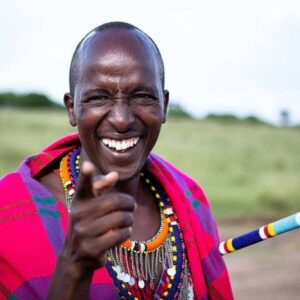 people of these countries are an example of the highest form of happiness – the ability to appreciate what they have. Kenyans are a gregarious, hospitable, easy-going, and intensely curious people. They take pleasure in meeting visitors and finding out about their way of life. Undungu, translated as “brotherhood,” conveys the spirit of Tanzanians; the idea of generosity, consideration, and compassion towards both family, and community. Any visitor to the country can expect to hear the Swahili word Karibu frequently. It means “welcome.”
people of these countries are an example of the highest form of happiness – the ability to appreciate what they have. Kenyans are a gregarious, hospitable, easy-going, and intensely curious people. They take pleasure in meeting visitors and finding out about their way of life. Undungu, translated as “brotherhood,” conveys the spirit of Tanzanians; the idea of generosity, consideration, and compassion towards both family, and community. Any visitor to the country can expect to hear the Swahili word Karibu frequently. It means “welcome.”
And that’s a warm puppy, for sure.
The World Happiness Report is a publication of the Sustainable Development Solutions Network, powered by the Gallup World Poll data.
» posted on Sunday, September 4th, 2022 by Linda Lou Burton
World Peace
Linda Lou Burton posting from Little Rock, Arkansas – One more post about dangers. Or should I say, SAFETY. Are you familiar with the Global Peace Index (GPI), an annual report produced by the Institute for Economics and Peace? This report presents the most comprehensive data-driven analysis to date on trends in peace, its economic value, and how to develop peaceful societies. The GPI covers 99.7% of the world’s population and 163 countries, using 23 qualitative and quantitative indicators from highly respected sources, and measures the state of peace across three domains:
- the level of Societal Safety and Security
- the extent of Ongoing Domestic and International Conflict
- the degree of Militarization.
If you’re the least bit interested in worldwide trends, go to their website for an in-depth look at the findings, and a look at the worldwide map. https://www.visionofhumanity.org/maps/#/
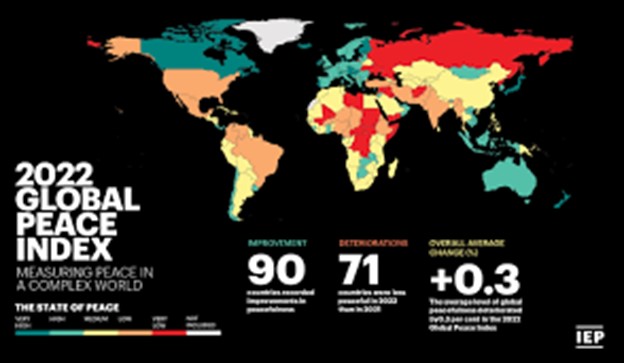 I checked this site as I thought about travel to Africa, and other parts of the world I plan to visit. The TOP TEN SAFEST COUNTRIES in the world in 2022, according to this study, are:
I checked this site as I thought about travel to Africa, and other parts of the world I plan to visit. The TOP TEN SAFEST COUNTRIES in the world in 2022, according to this study, are:
- Iceland. 2. New Zealand. 3. Ireland. 4. Denmark. 5. Austria. 6. Portugal. 7. Slovenia. 8. Czech Republic. 9. Singapore. 10. Japan
 Iceland has held the position of “Most Peaceful Country” since 2008. Afghanistan is the least peaceful country for the fifth consecutive year, at the bottom of the list of 163 countries in the world. Yemen, Syria, Russia and South Sudan complete the bottom five. Noted this year:
Iceland has held the position of “Most Peaceful Country” since 2008. Afghanistan is the least peaceful country for the fifth consecutive year, at the bottom of the list of 163 countries in the world. Yemen, Syria, Russia and South Sudan complete the bottom five. Noted this year:
- Deaths from external conflict recorded a sharp deterioration driven by the Russian invasion of Ukraine.
- The rise in costs has increased food insecurity and political instability globally, with Africa, South Asia and the Middle East under greatest threat.
- The political terror scale, political insecurity, neighboring country relations, refugees and IDPs reached their worst score since the inception of the GPI.
Seven of the ten countries at the TOP of the Global Peace Index are in Europe.
The safety rankings of the countries we’ll be visiting and returning to:
- Iceland – #1
- Tanzania – #86
- Kenya – #120
- United States – #129
This photo was taken February 7, 2022 with a zoom lens from my bedroom window, as a Memorial Service was conducted in the City Park behind my house. A young man was killed in a shoot-out near the Park a few weeks earlier. A large crowd attended the Memorial Service, lighting candles and offering prayers for better community relations in Little Rock. I have lost count of the shootings in Little Rock this year alone.
I too pray for peace – in my community, my country, and my world.

